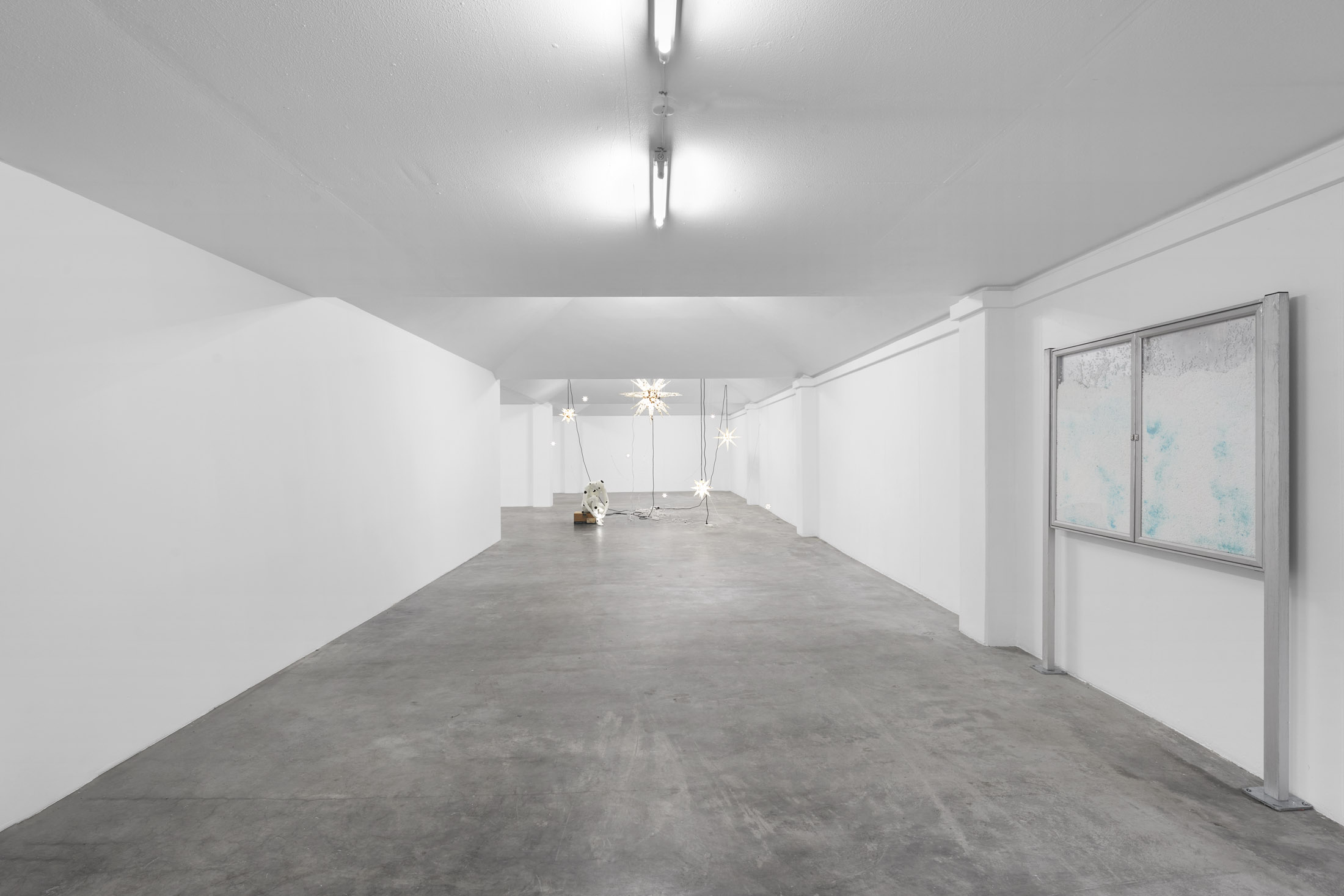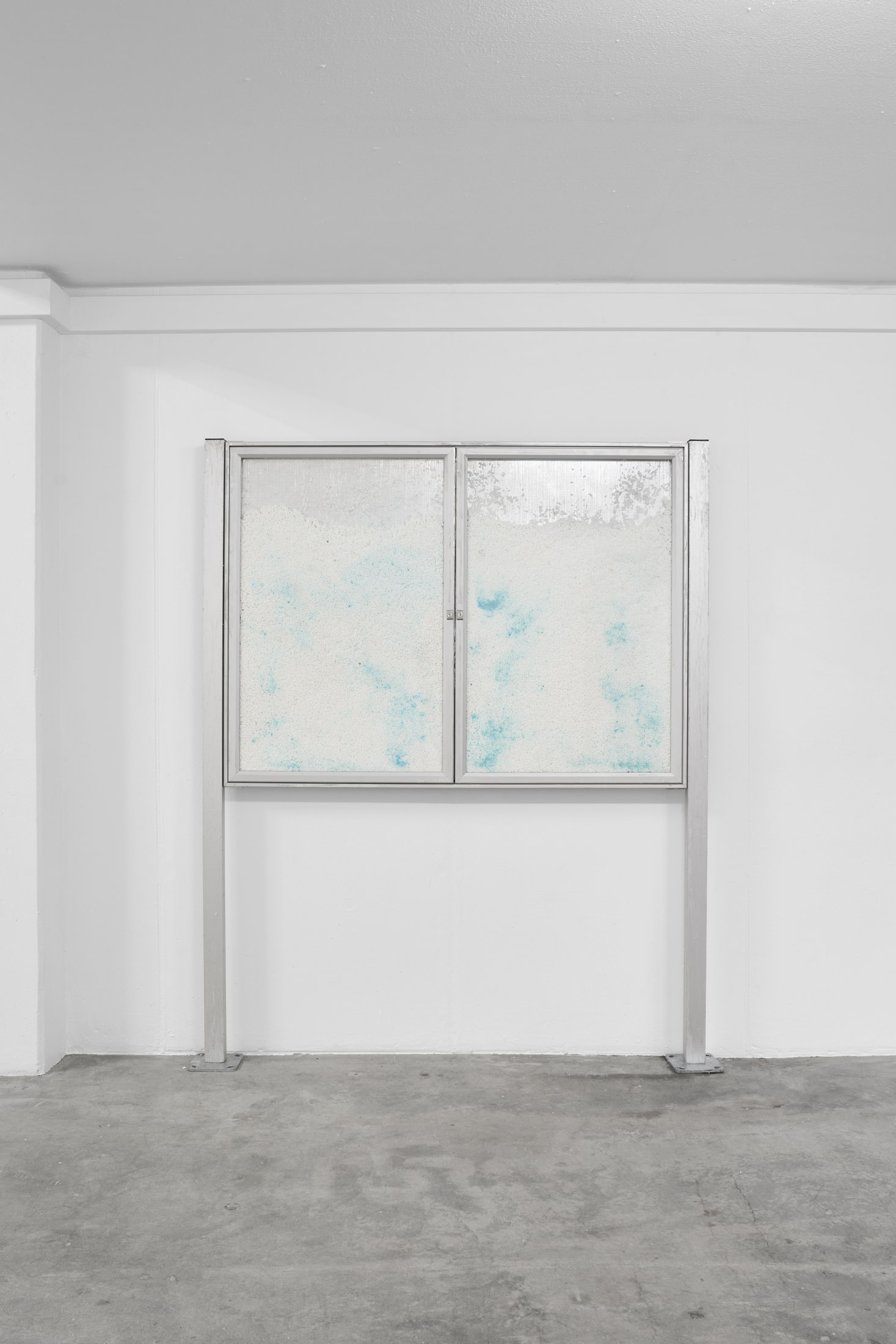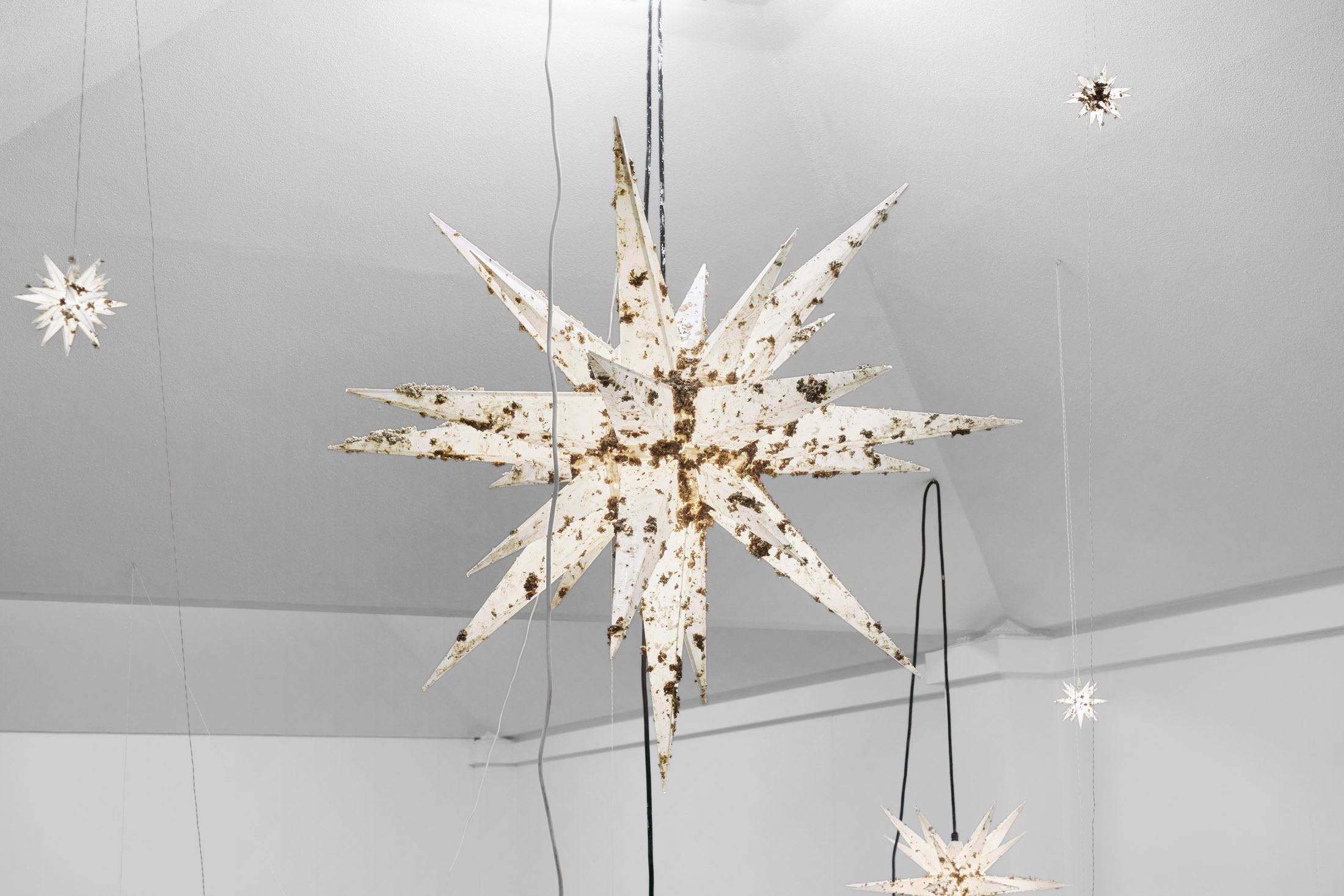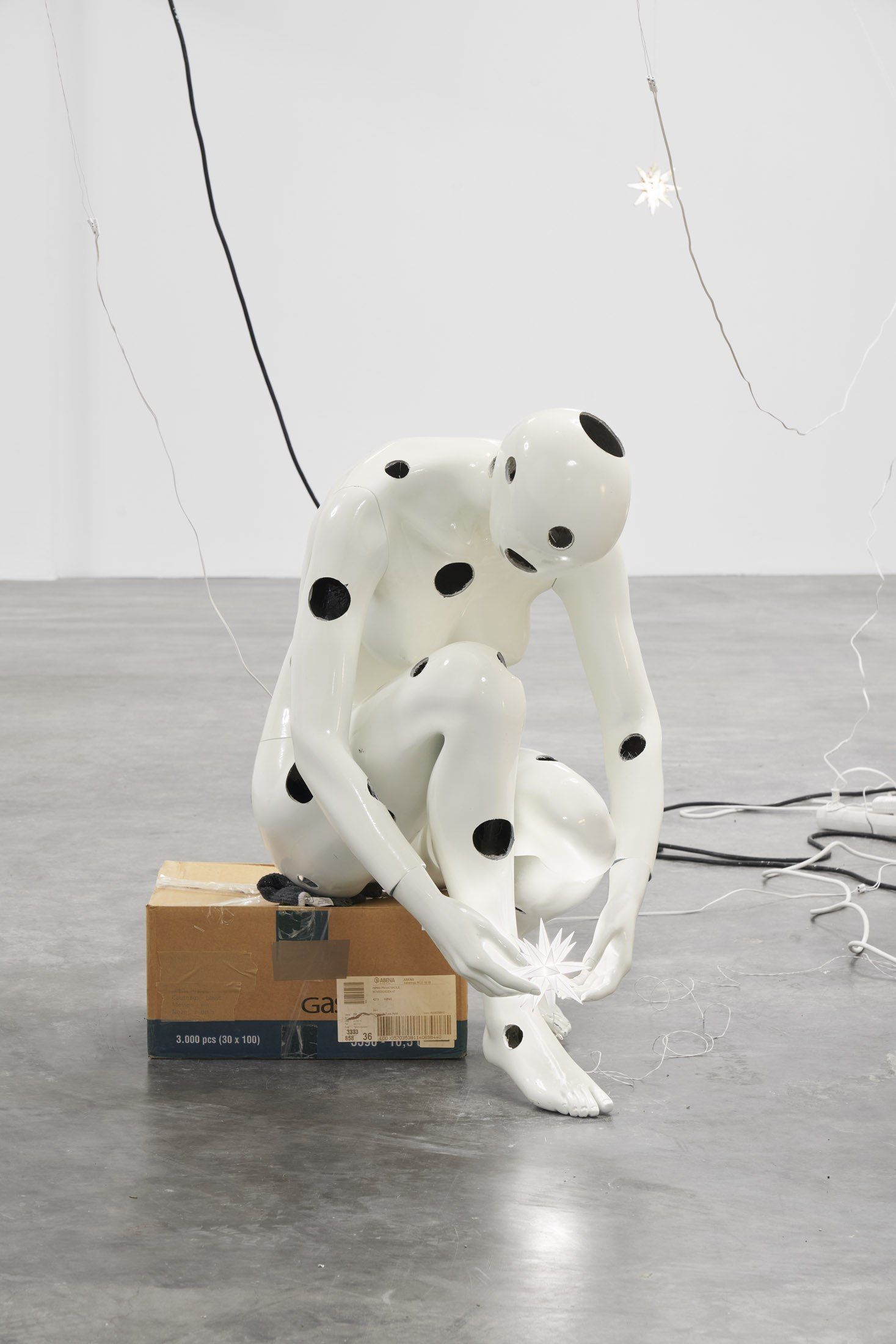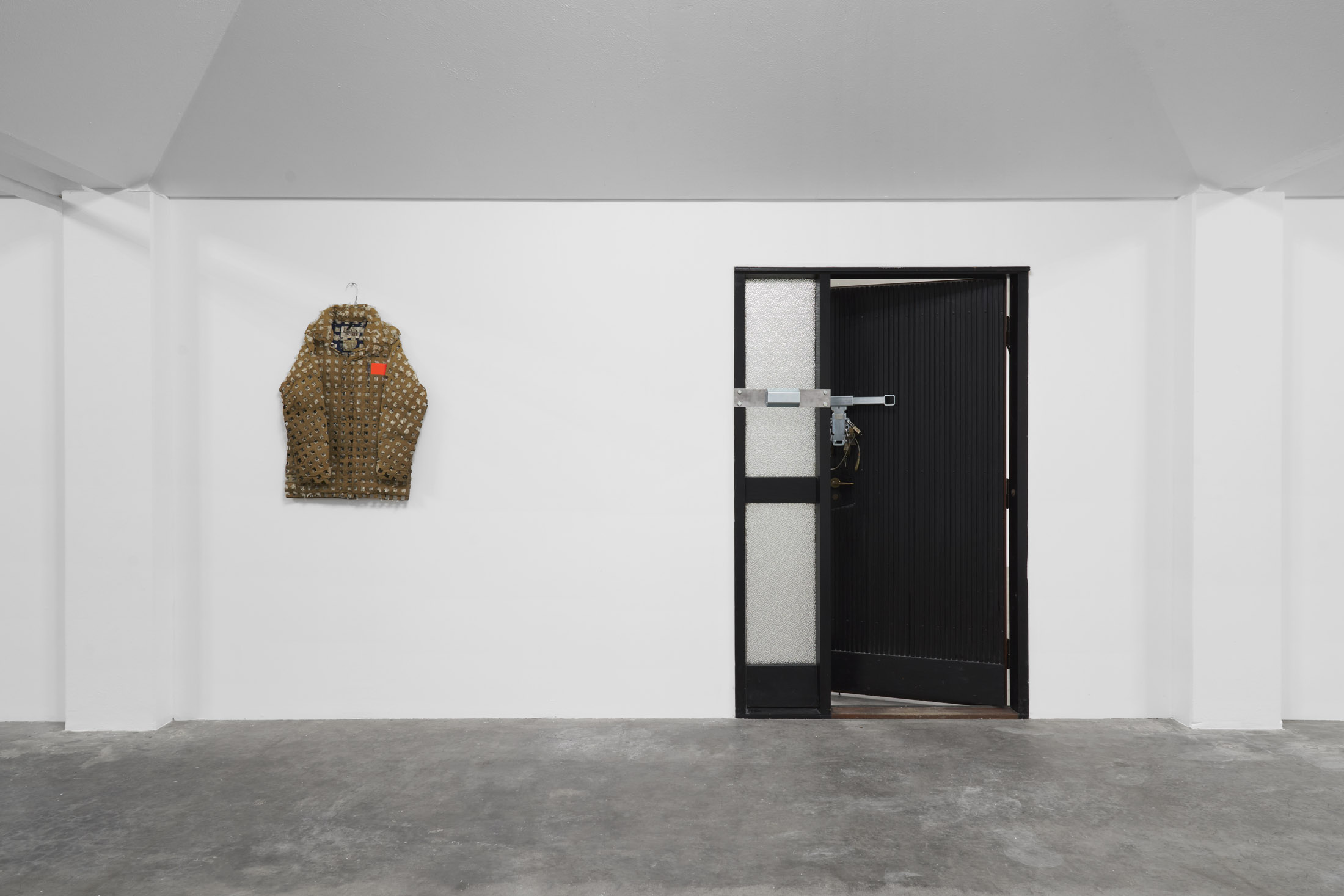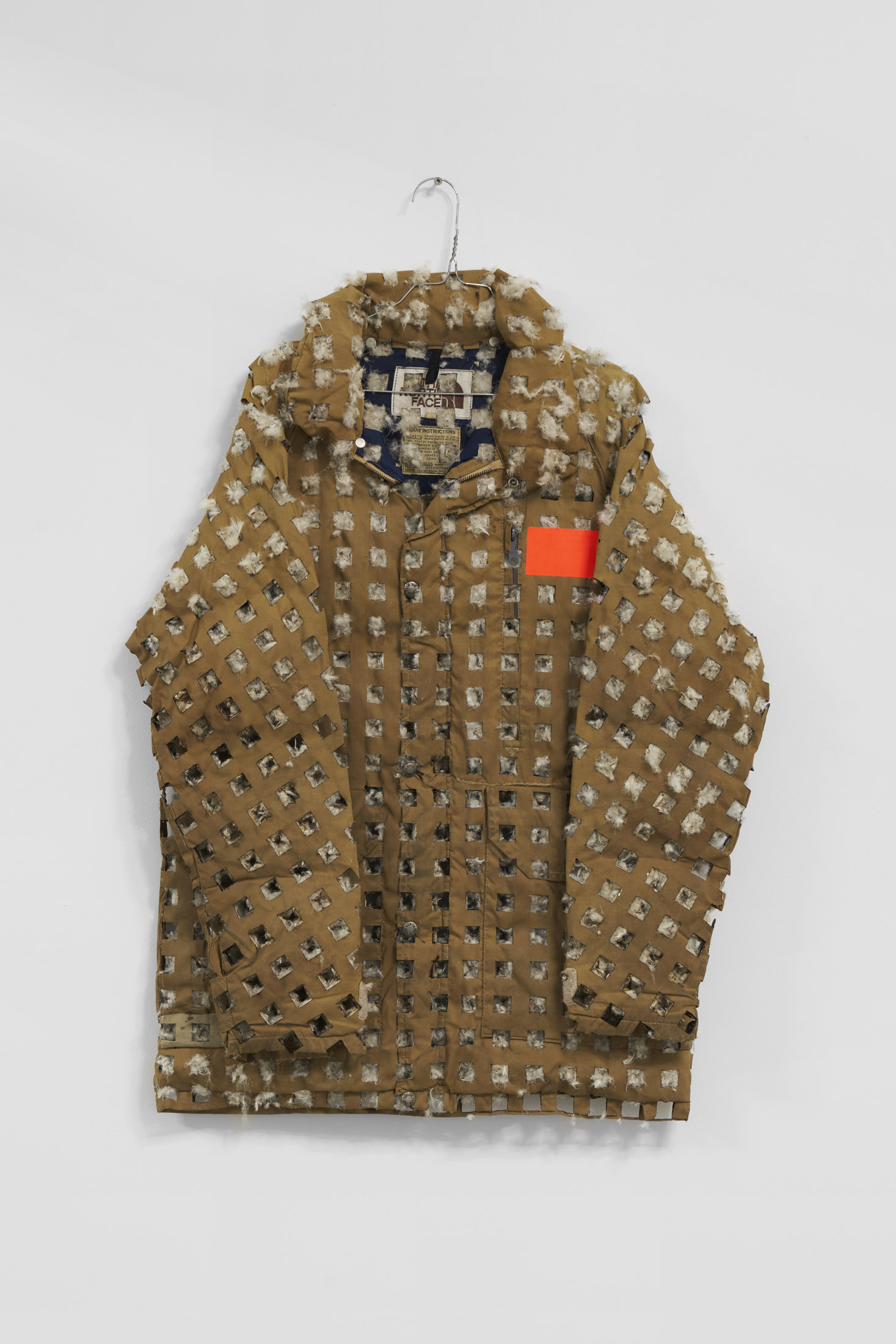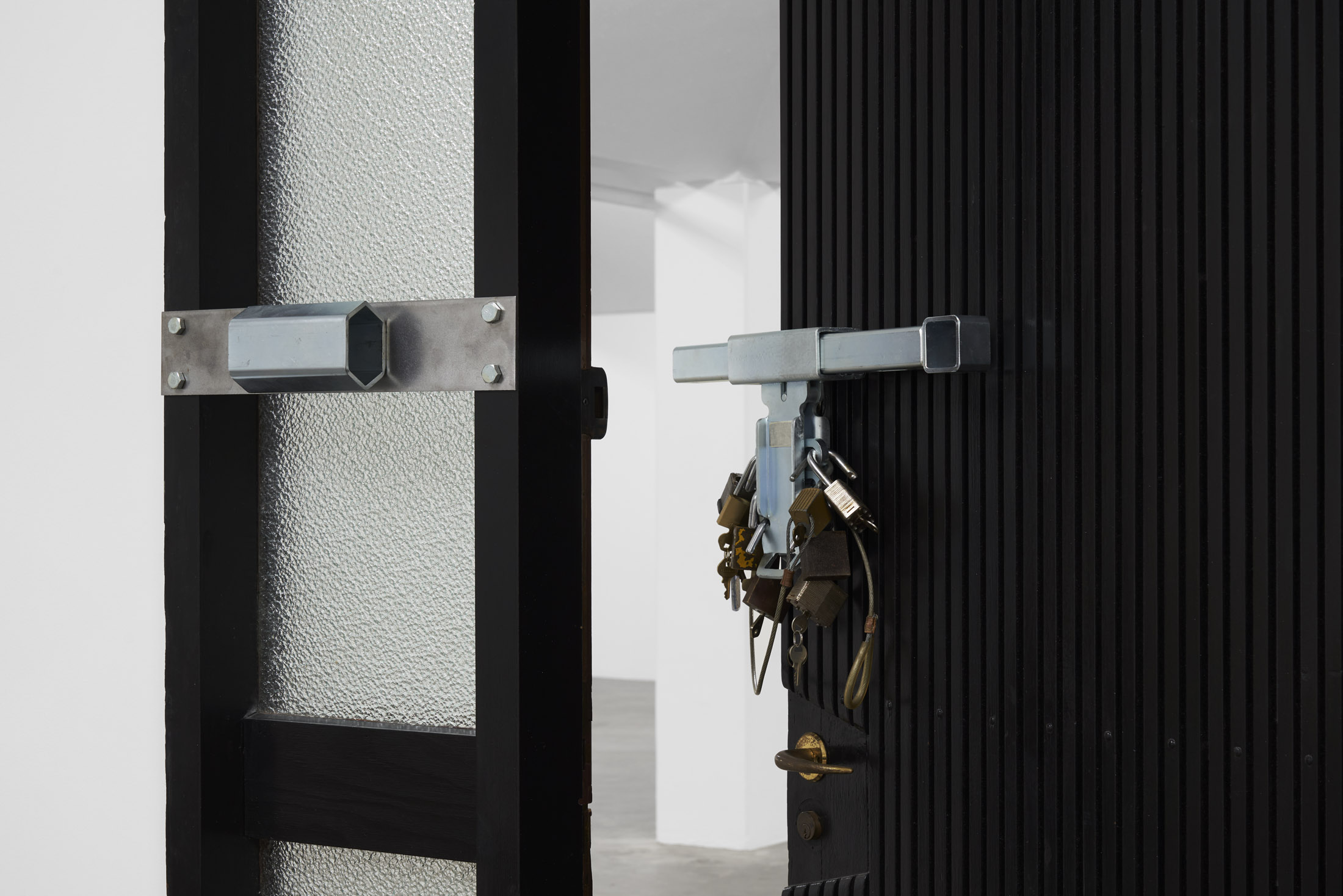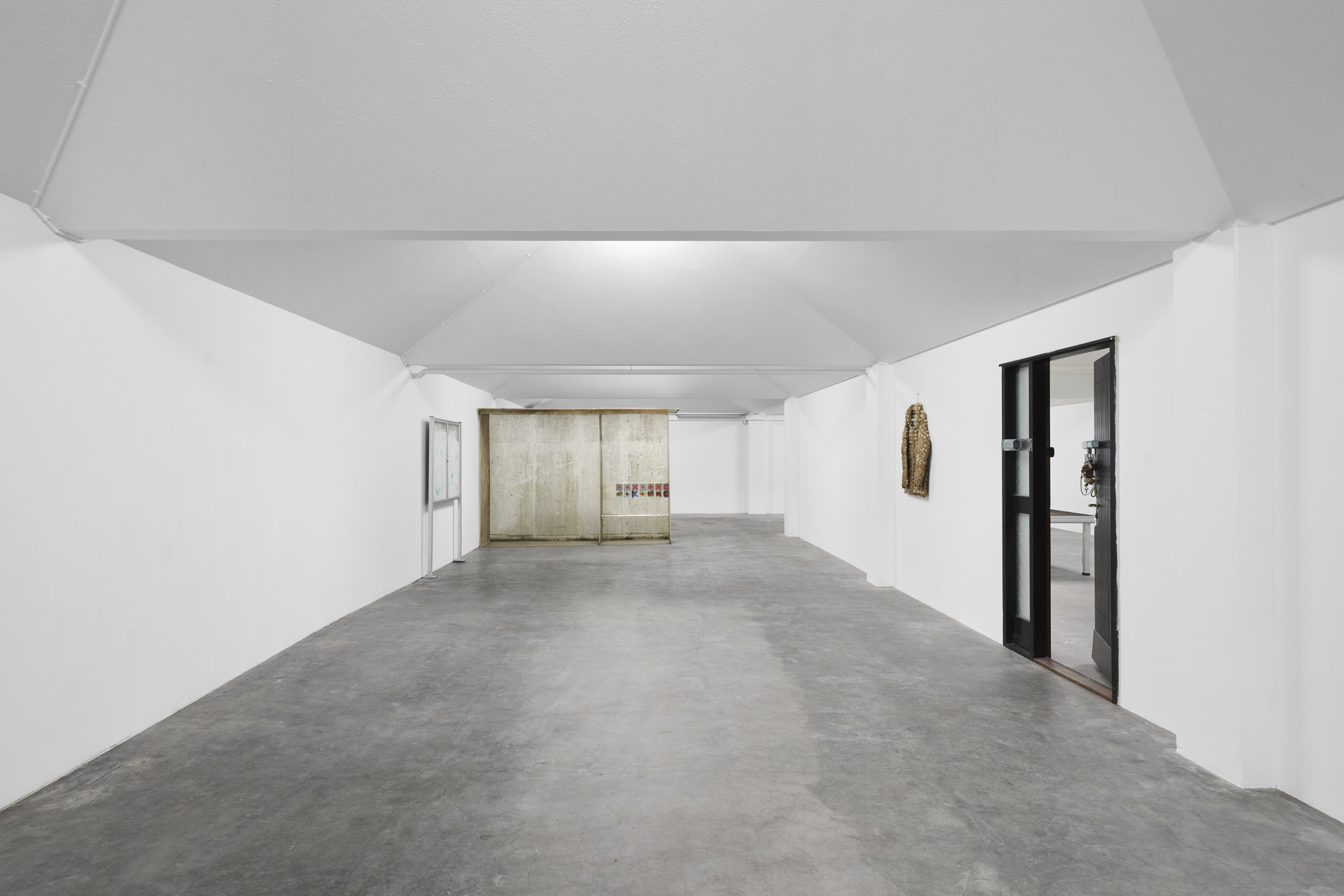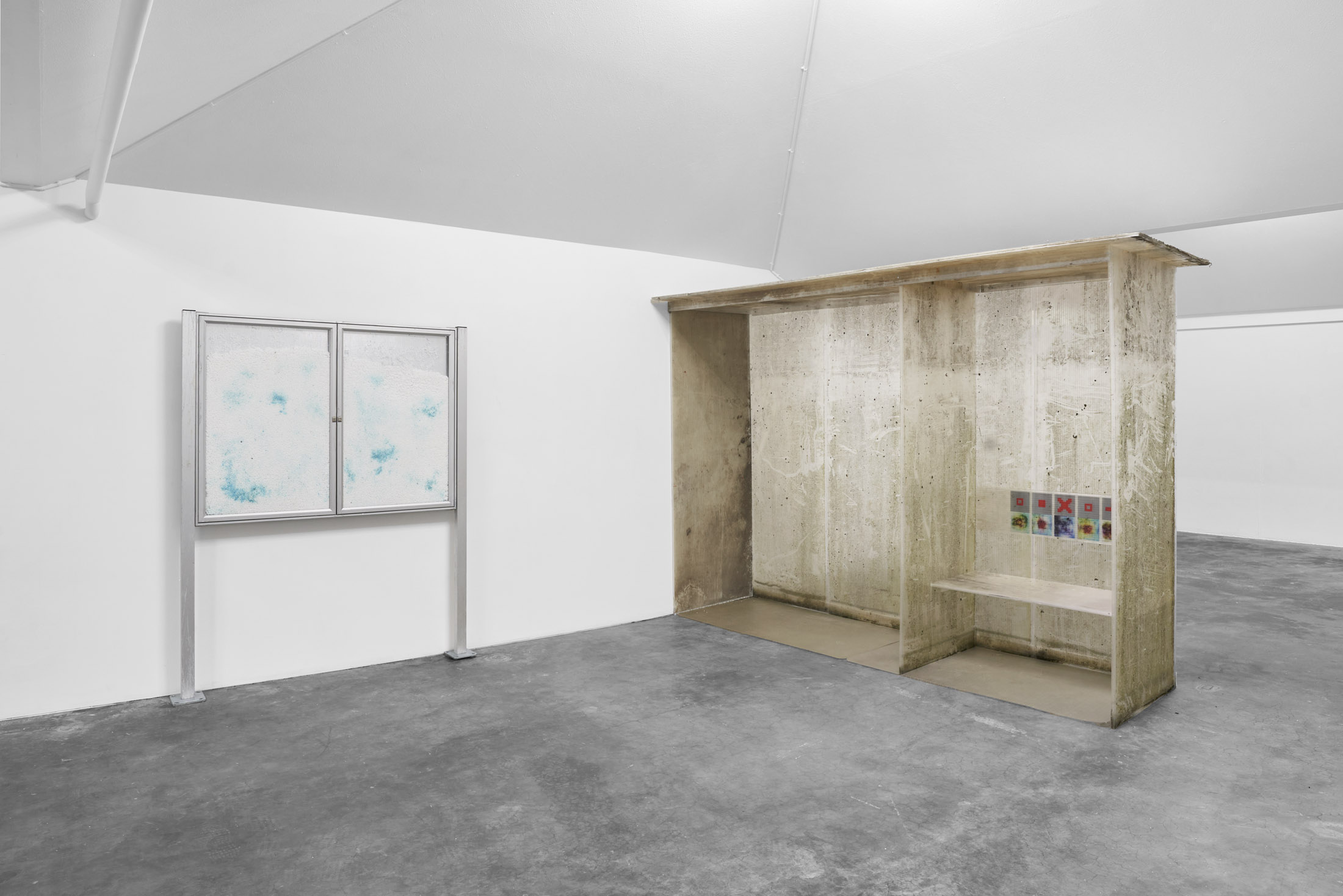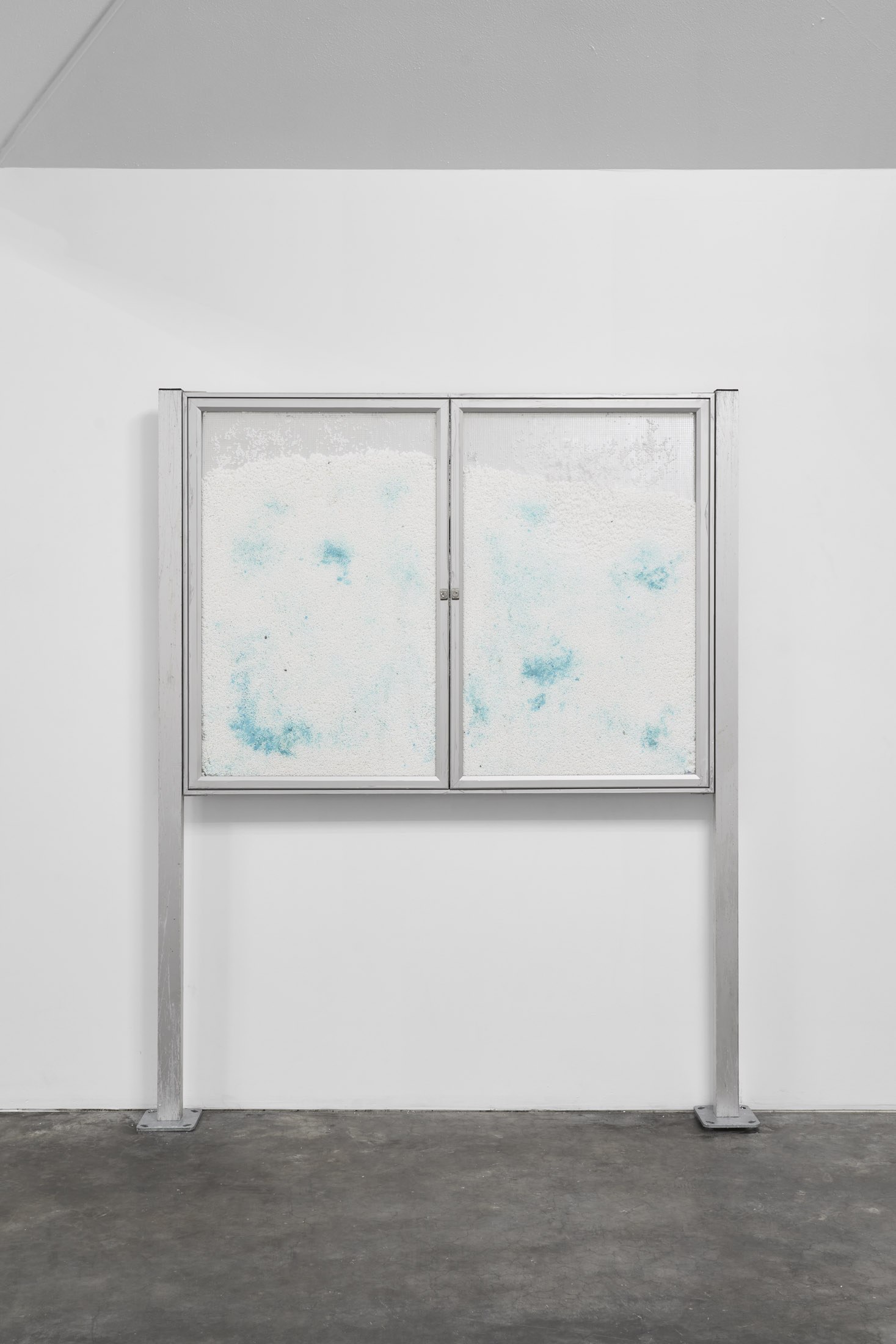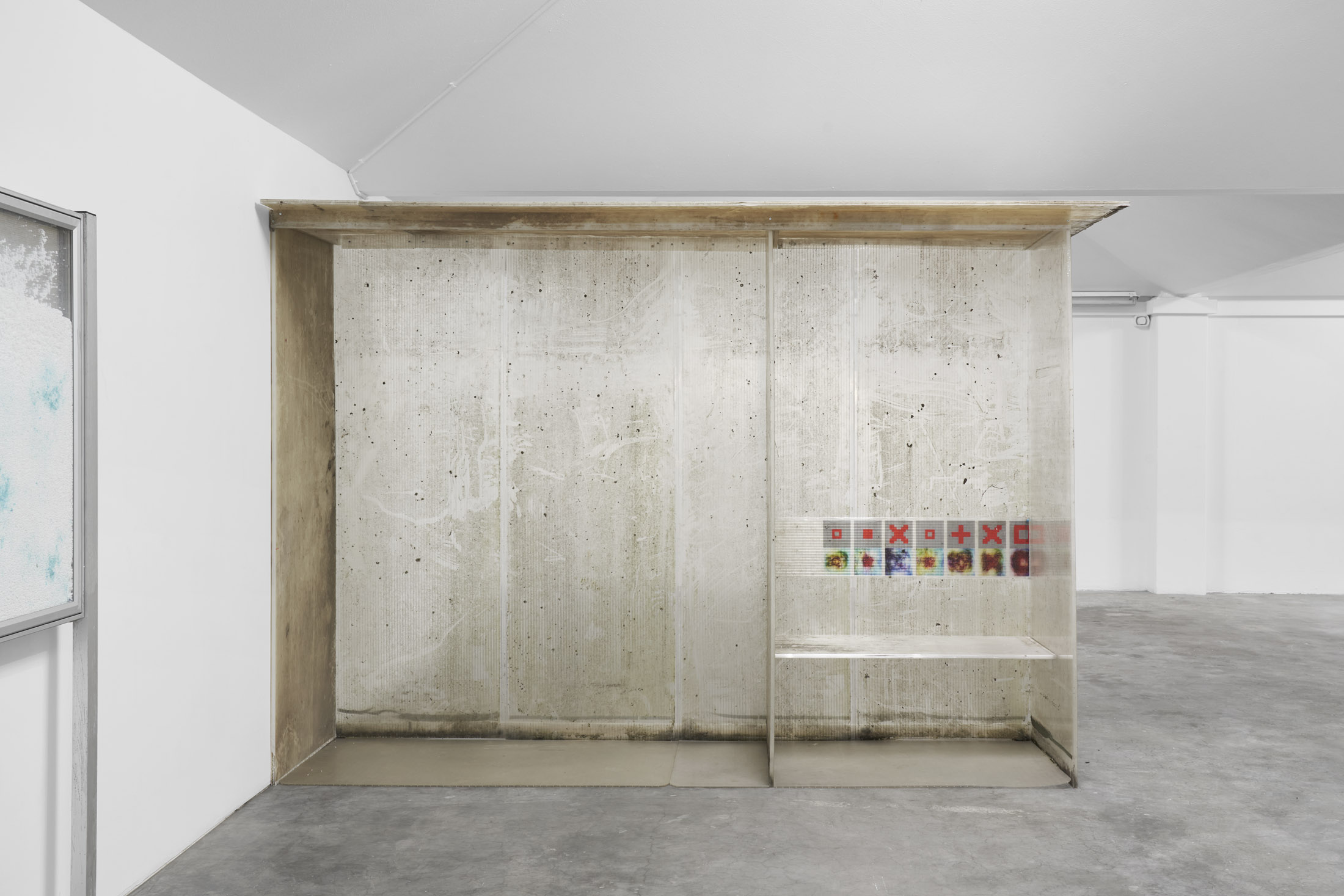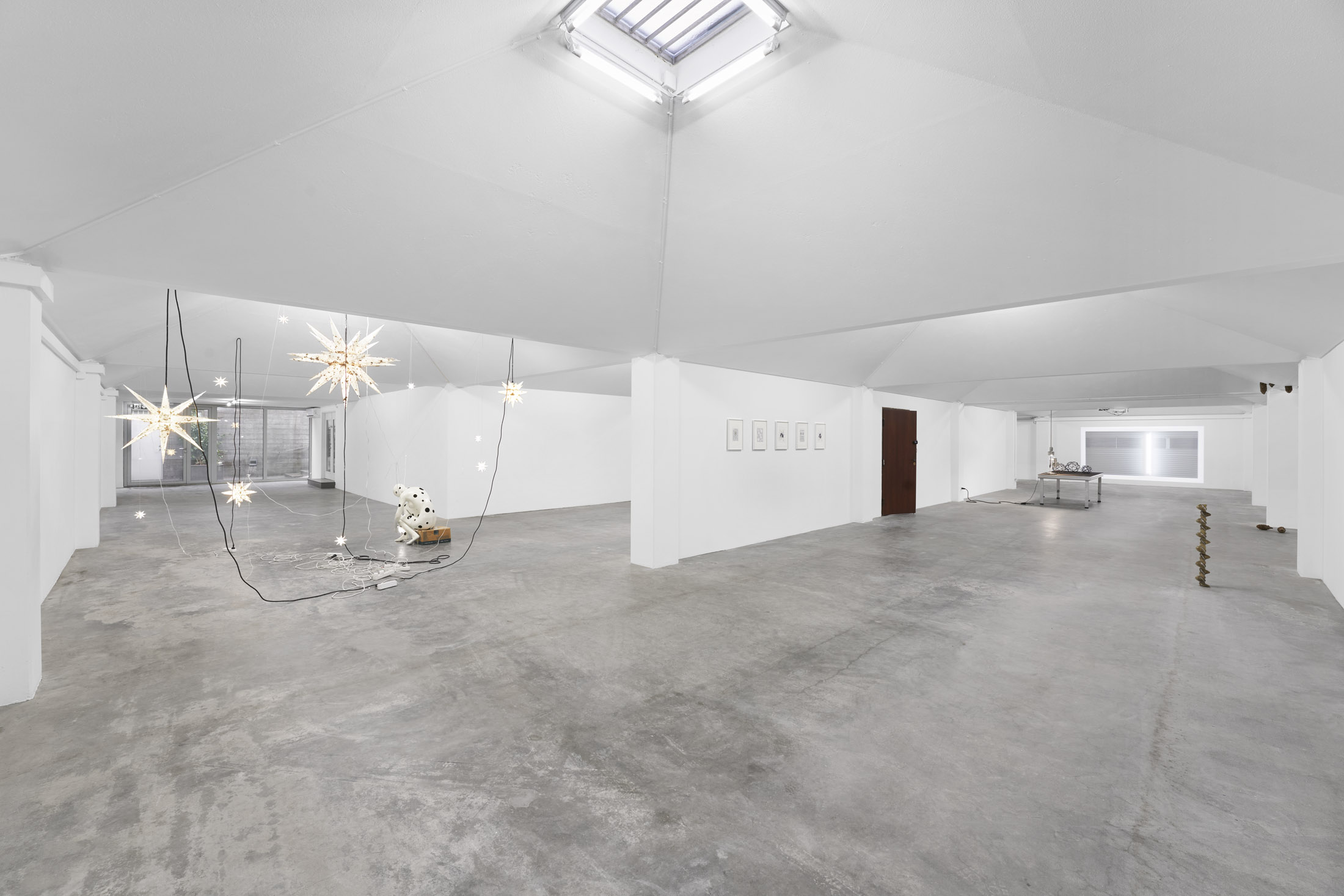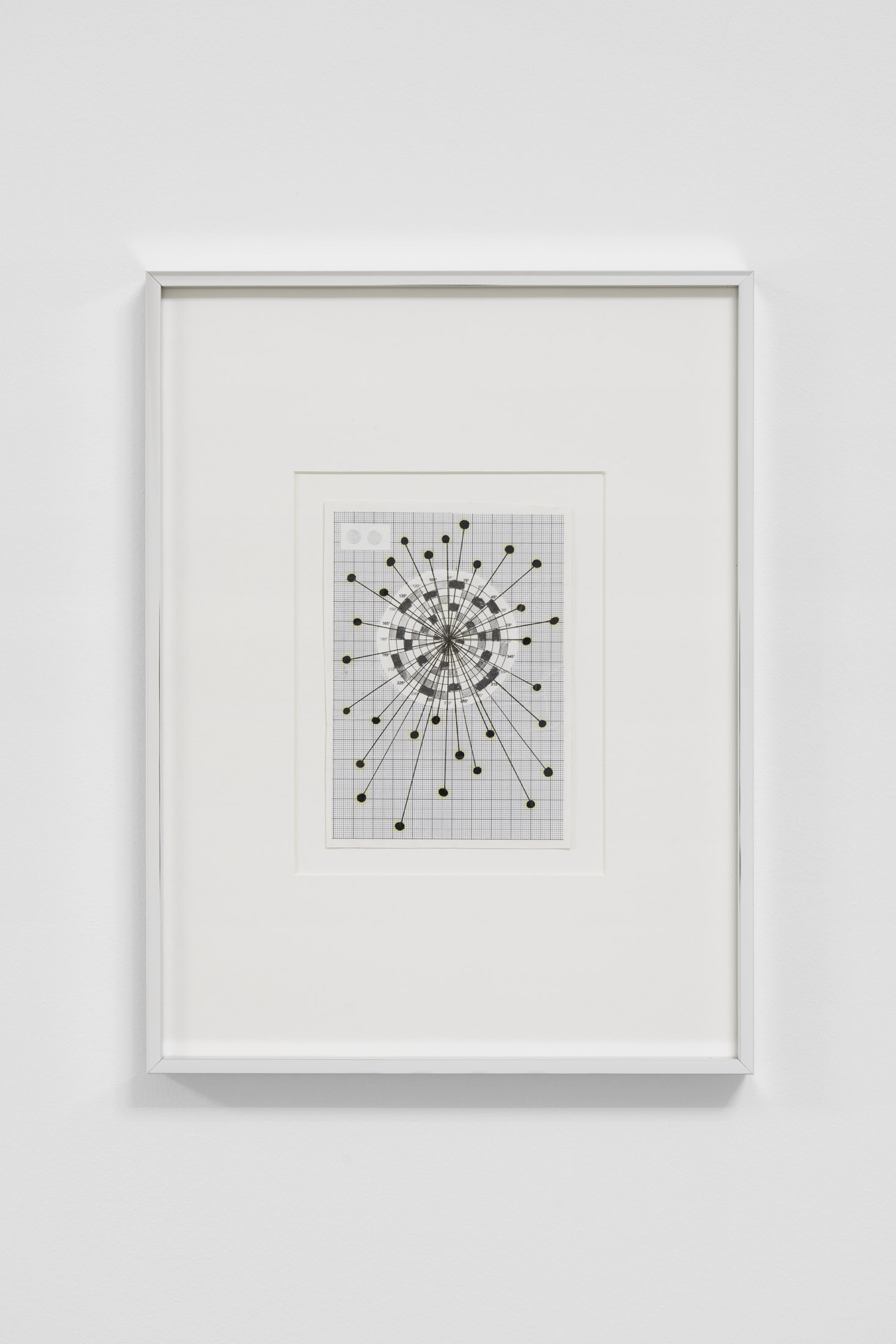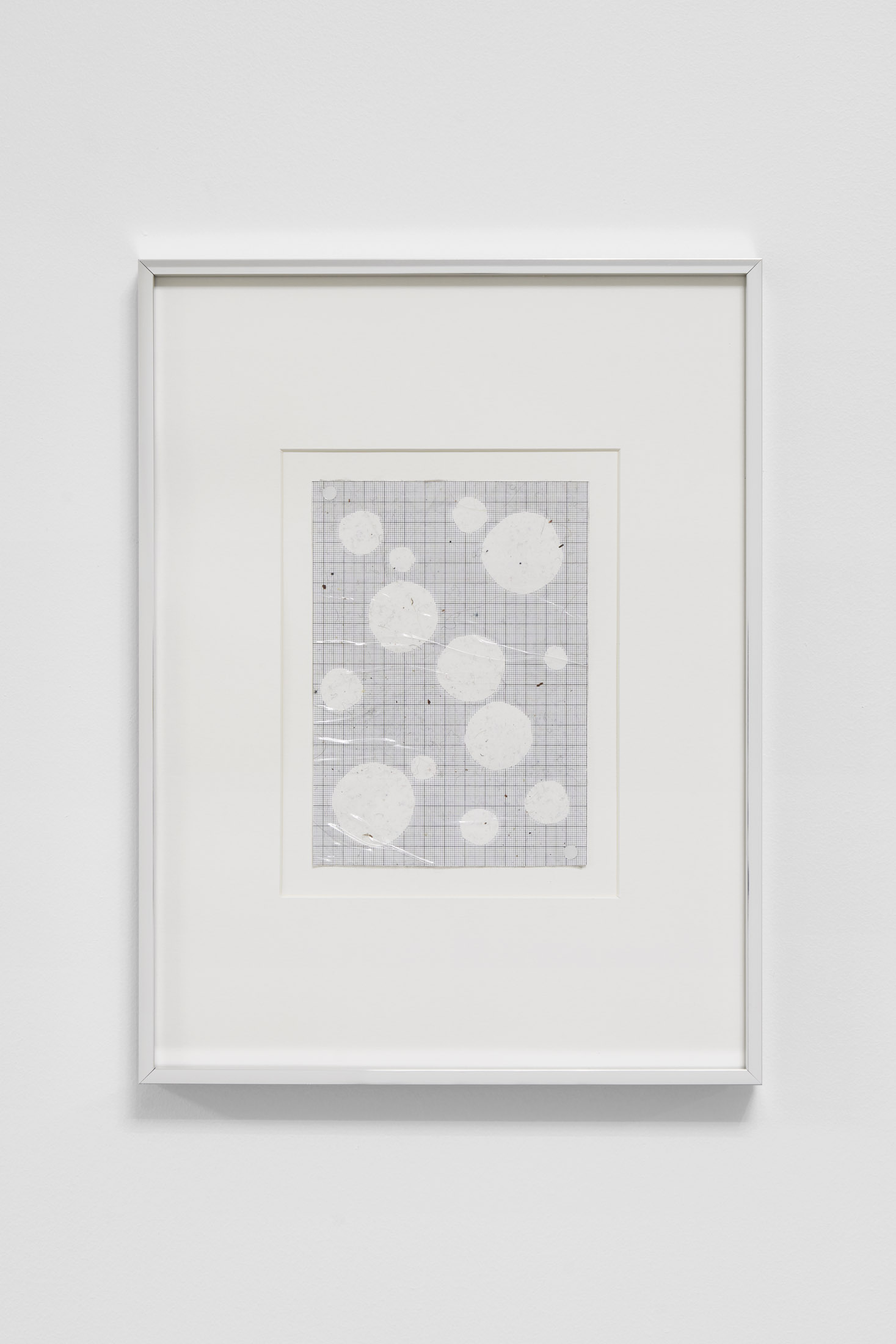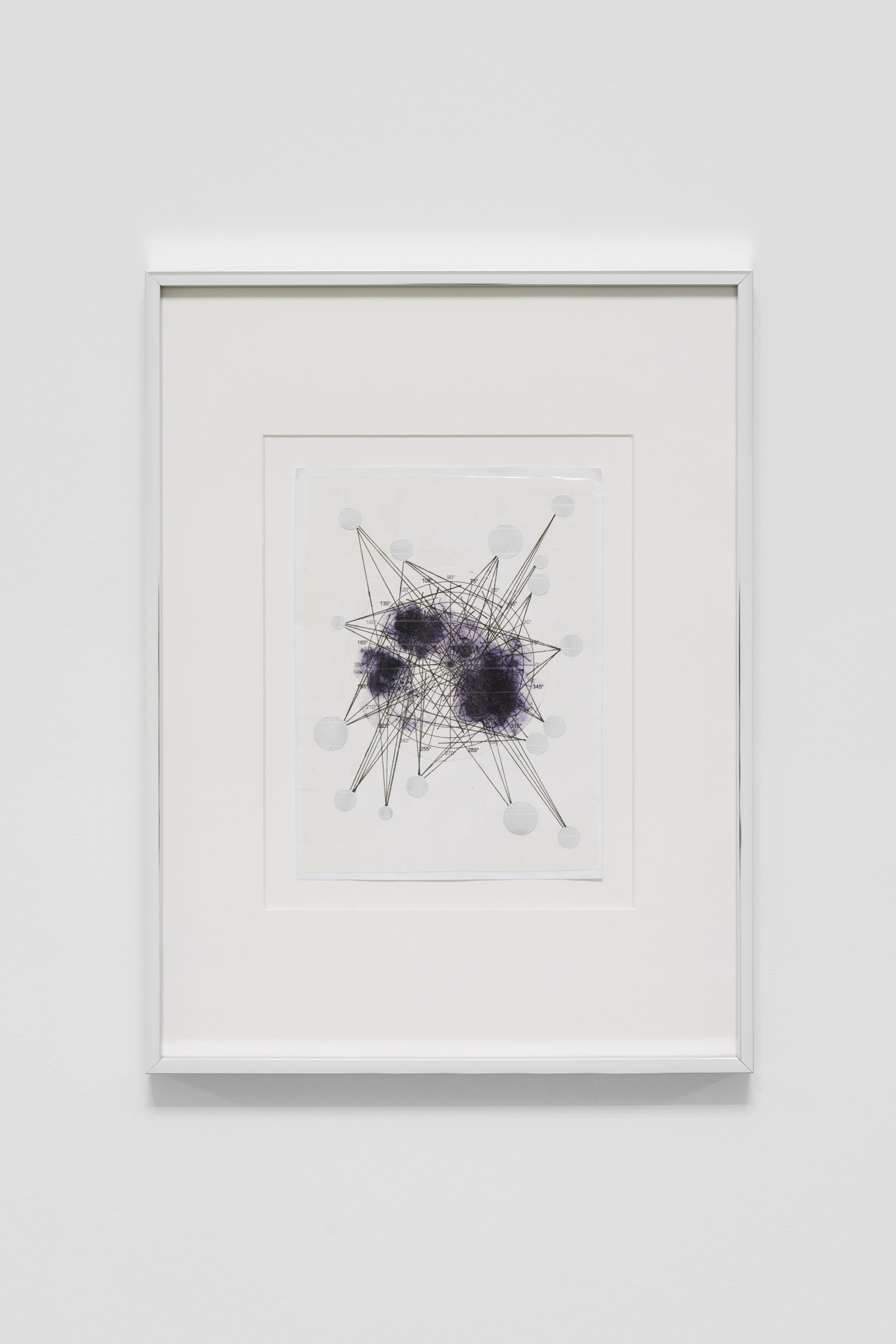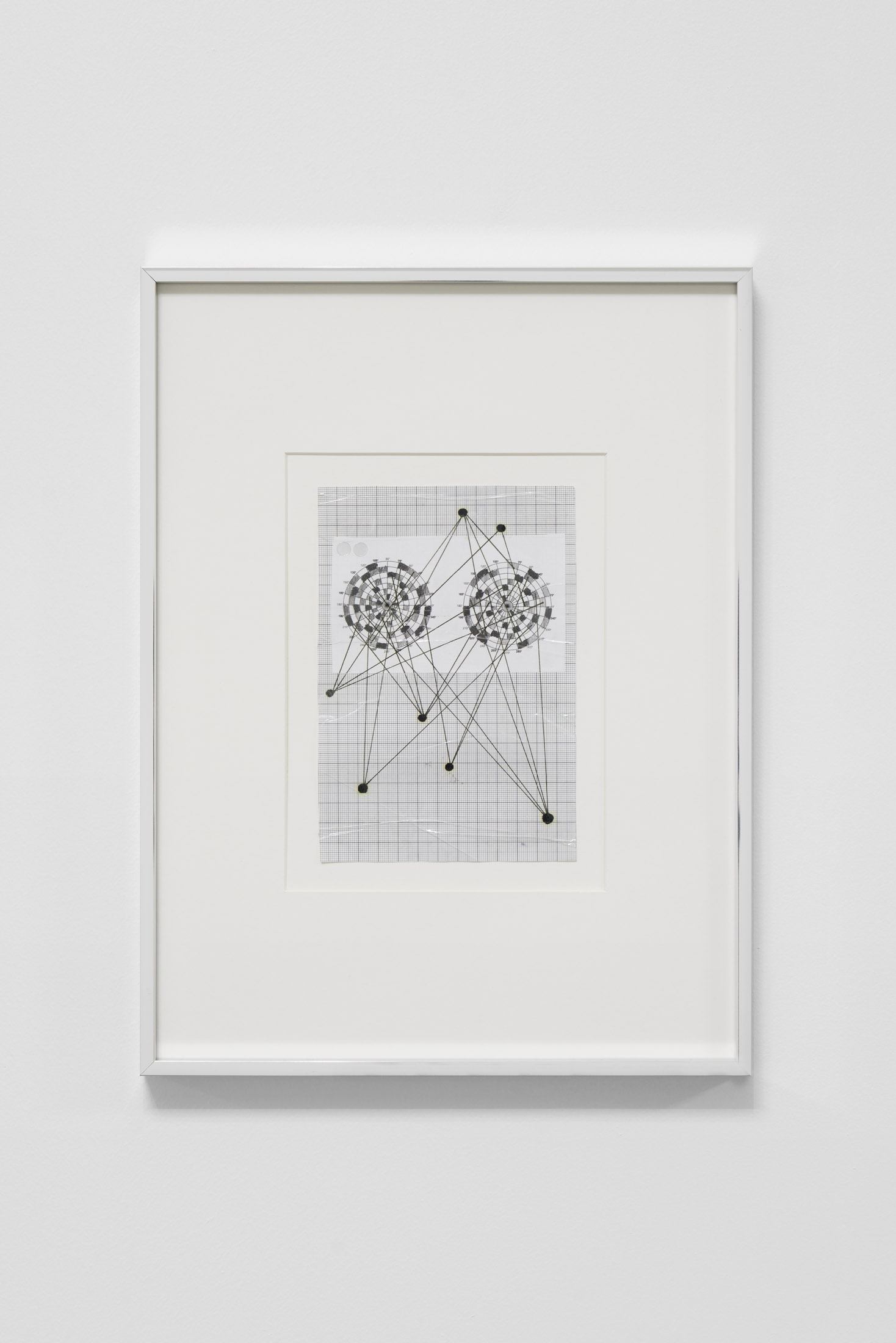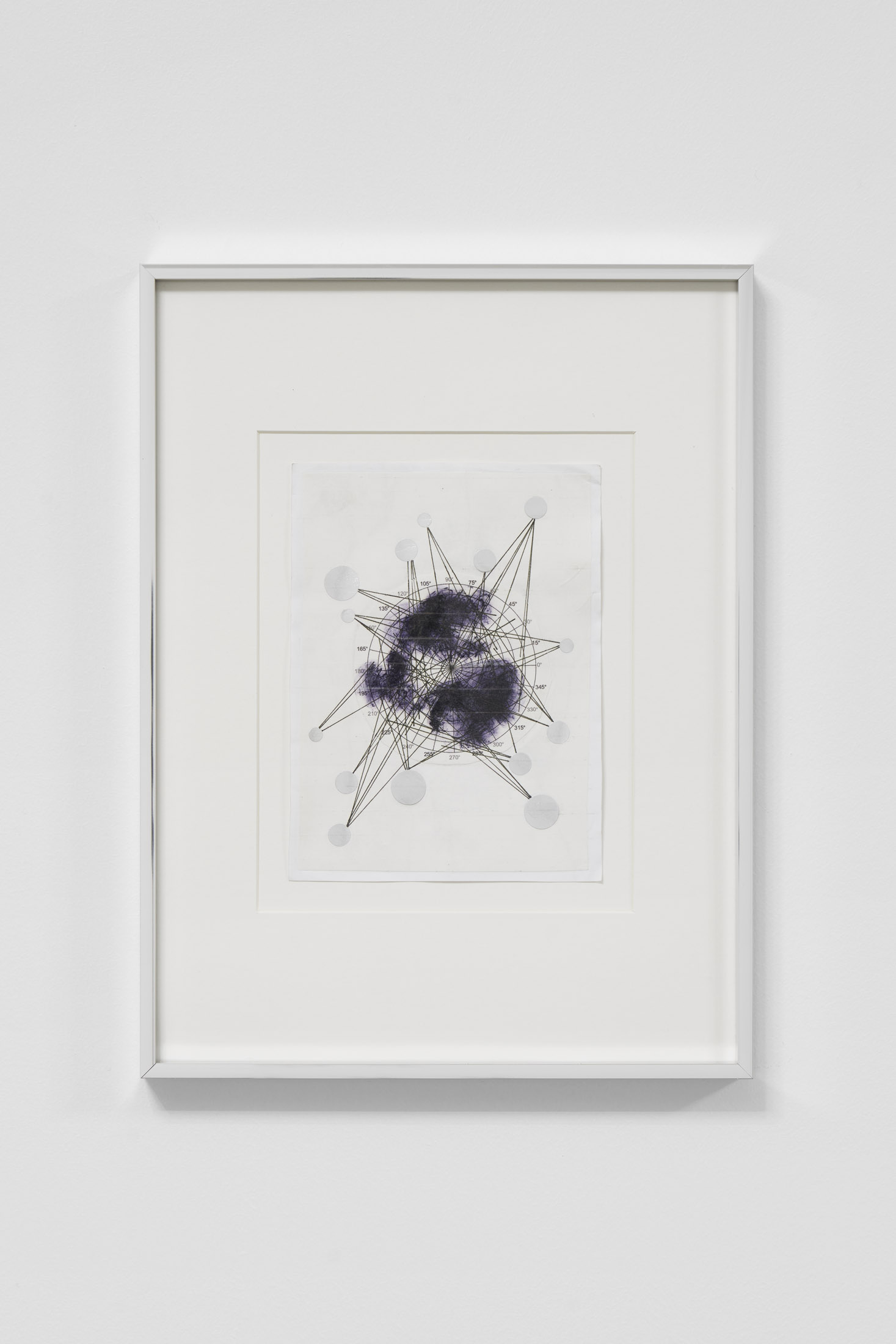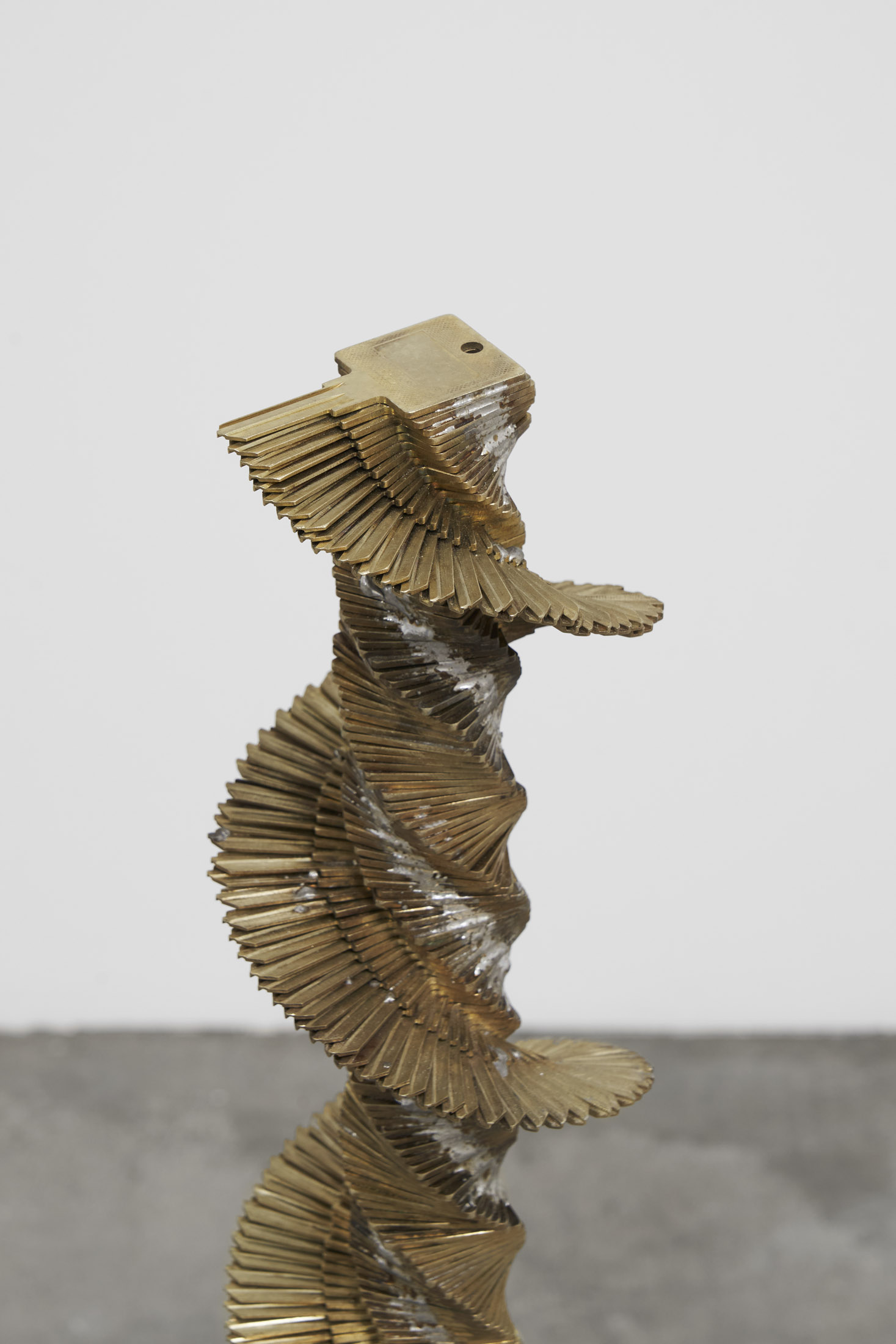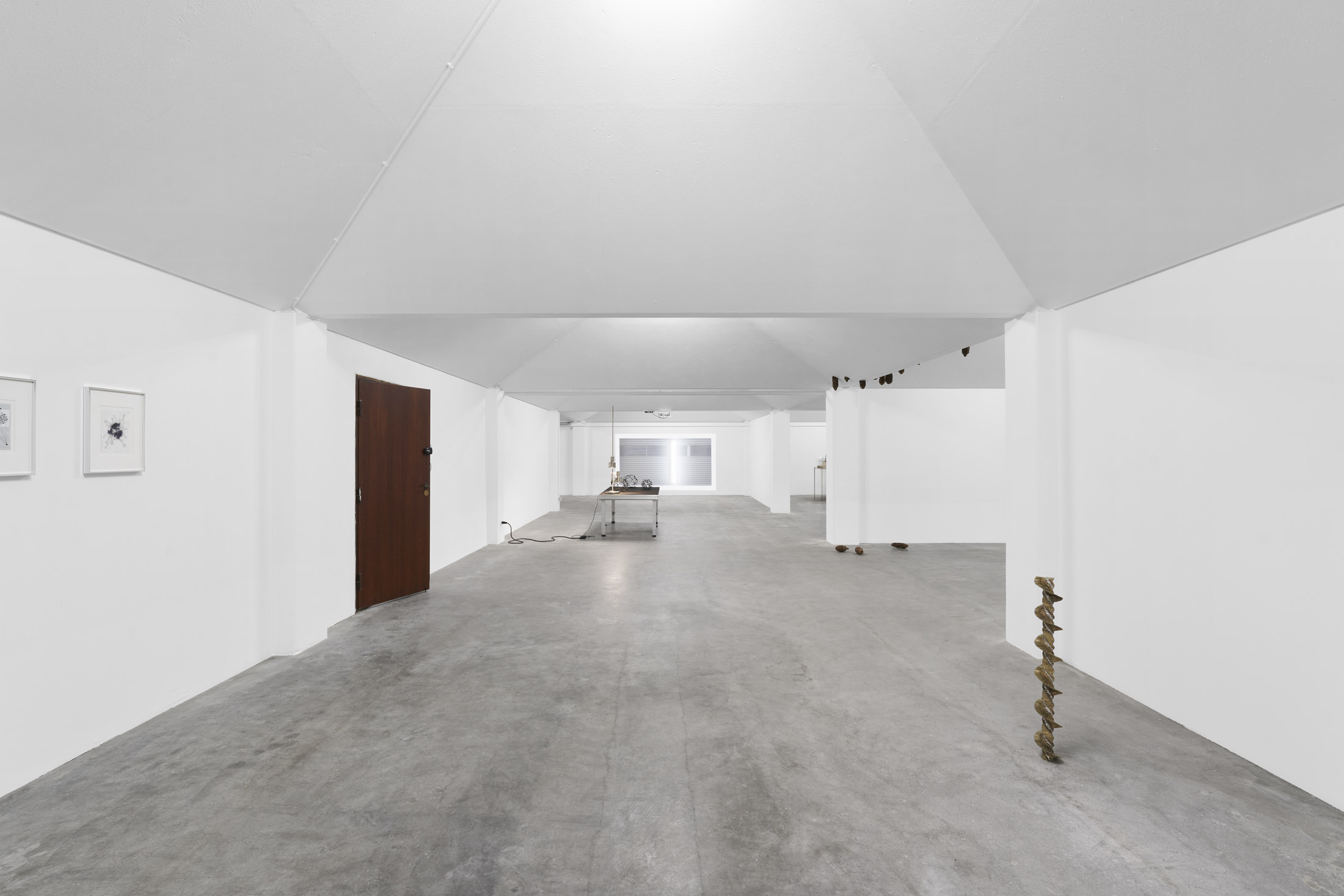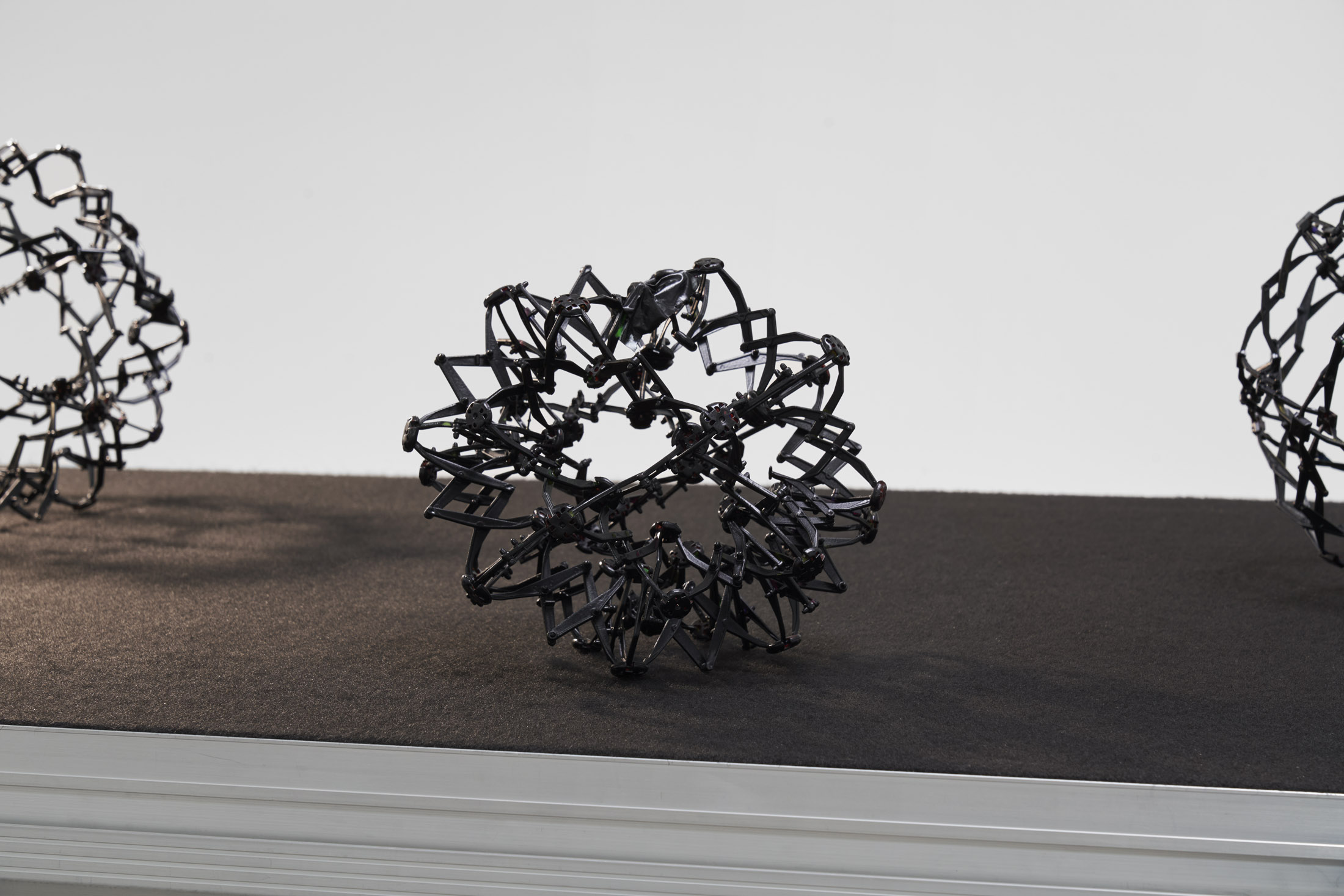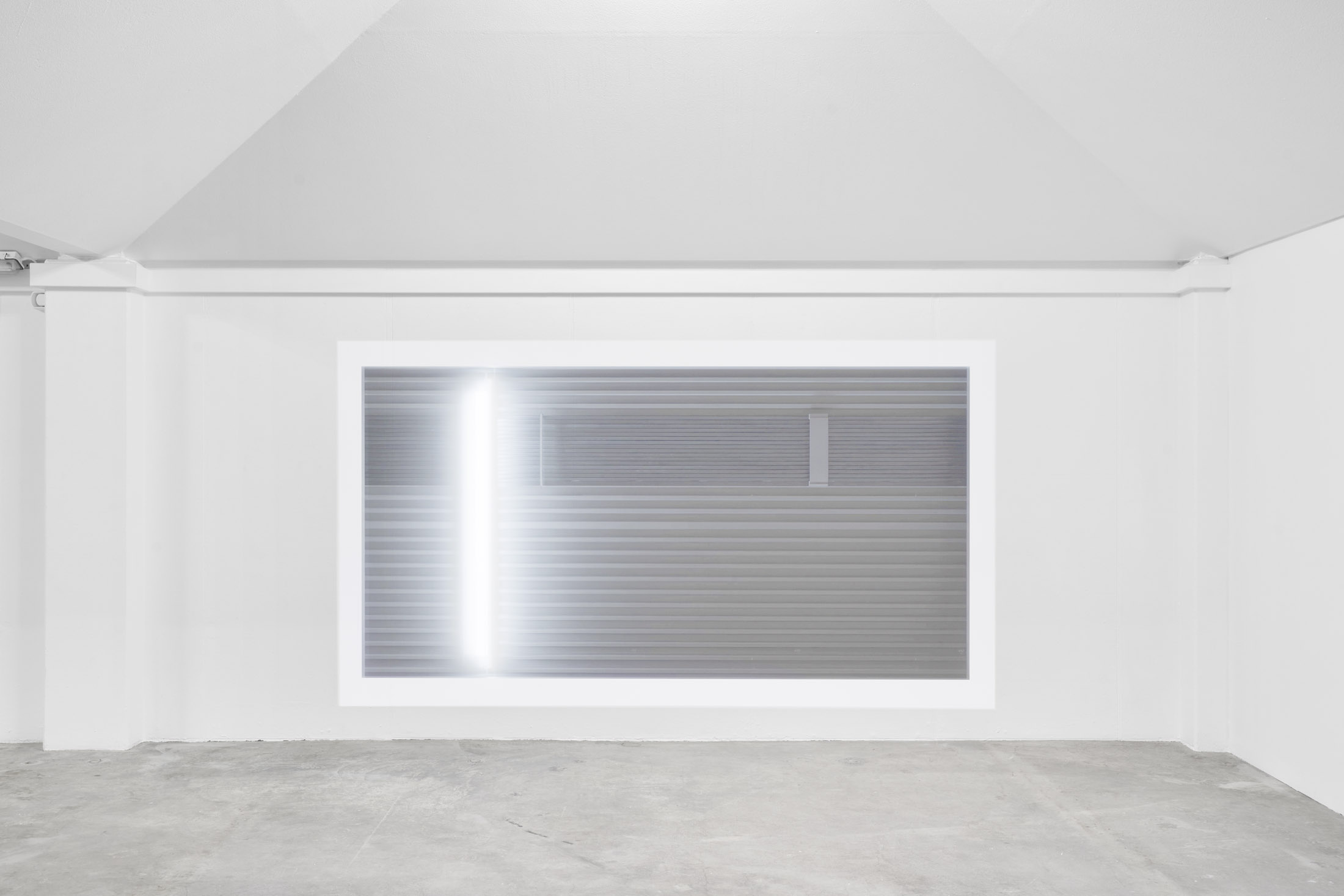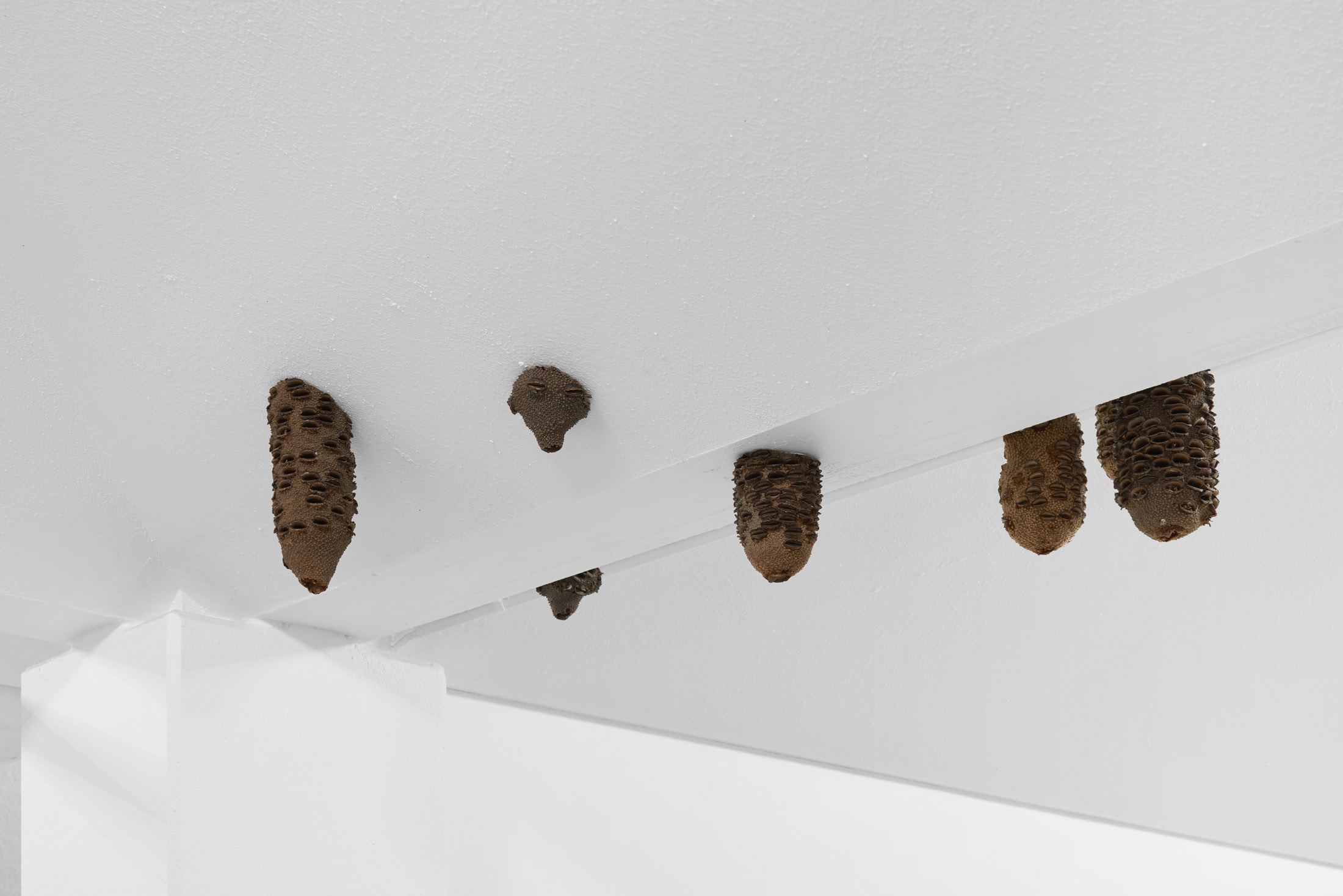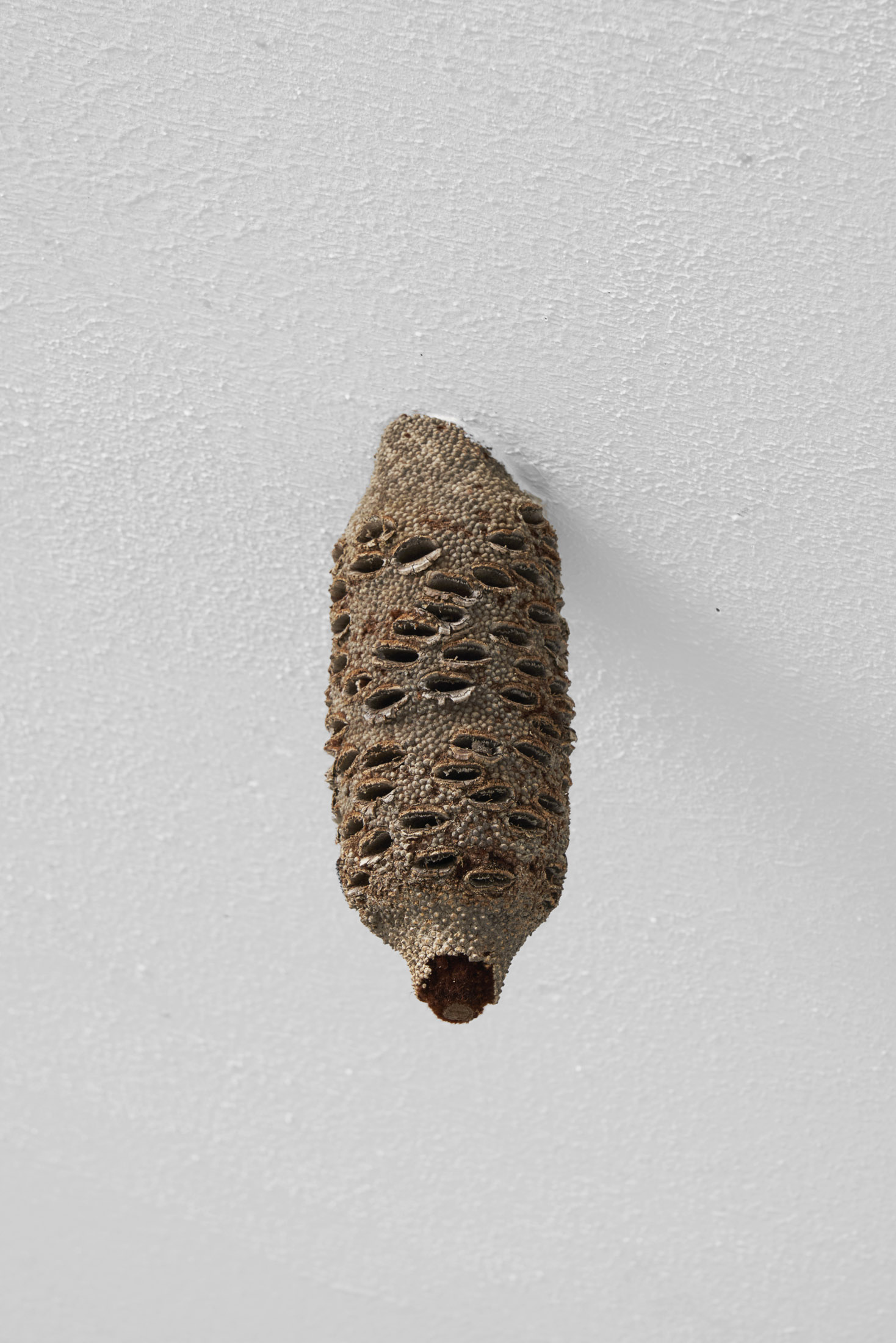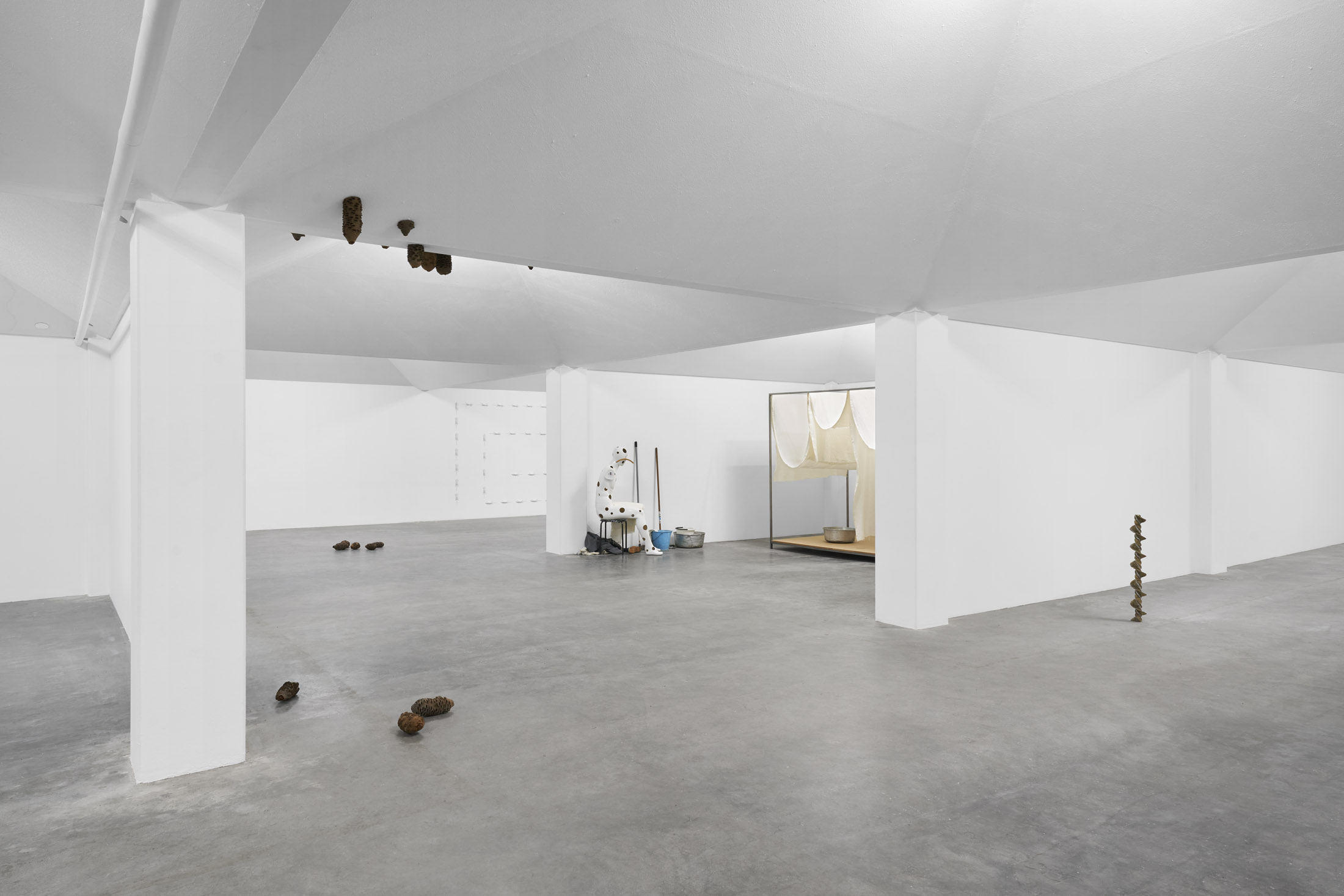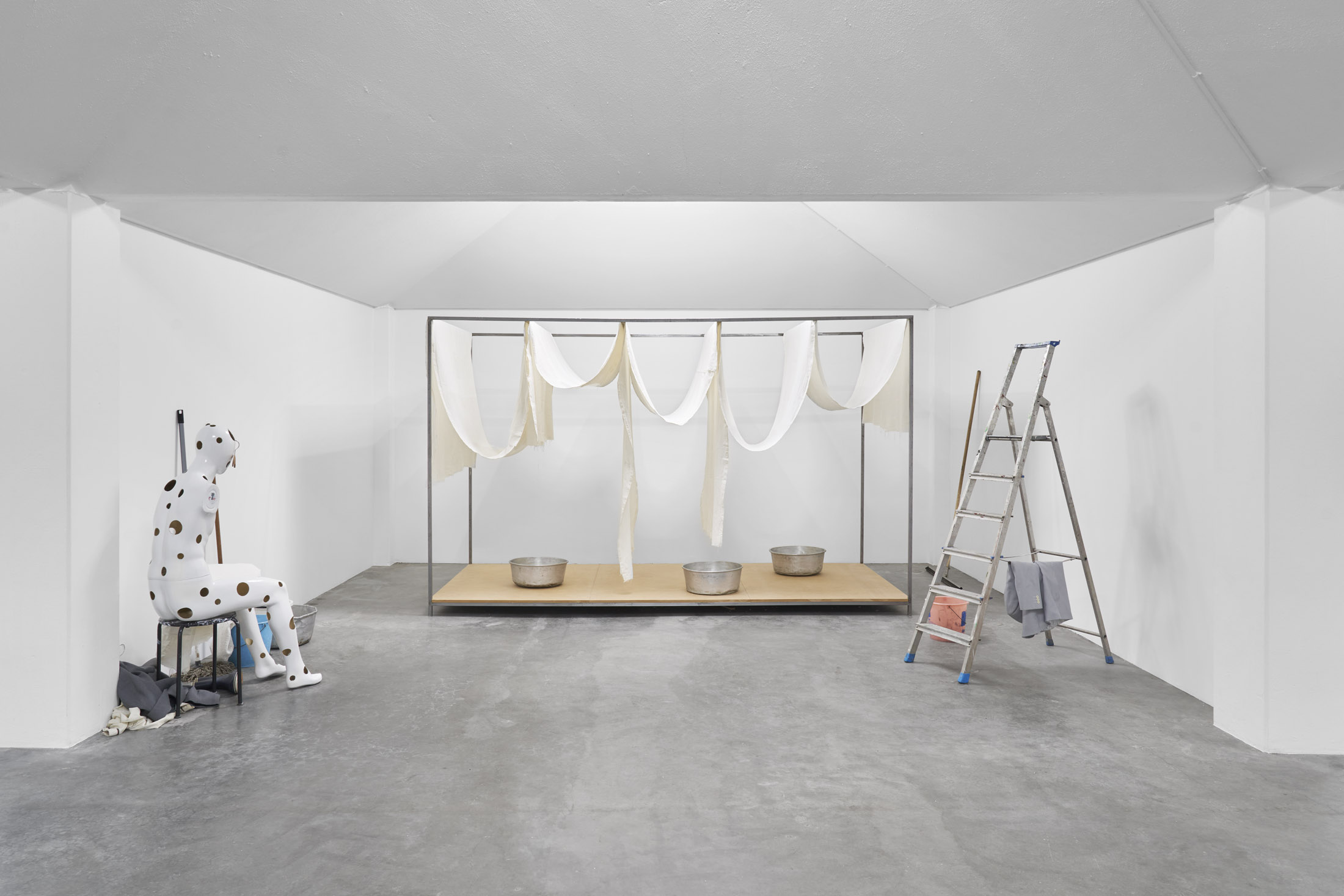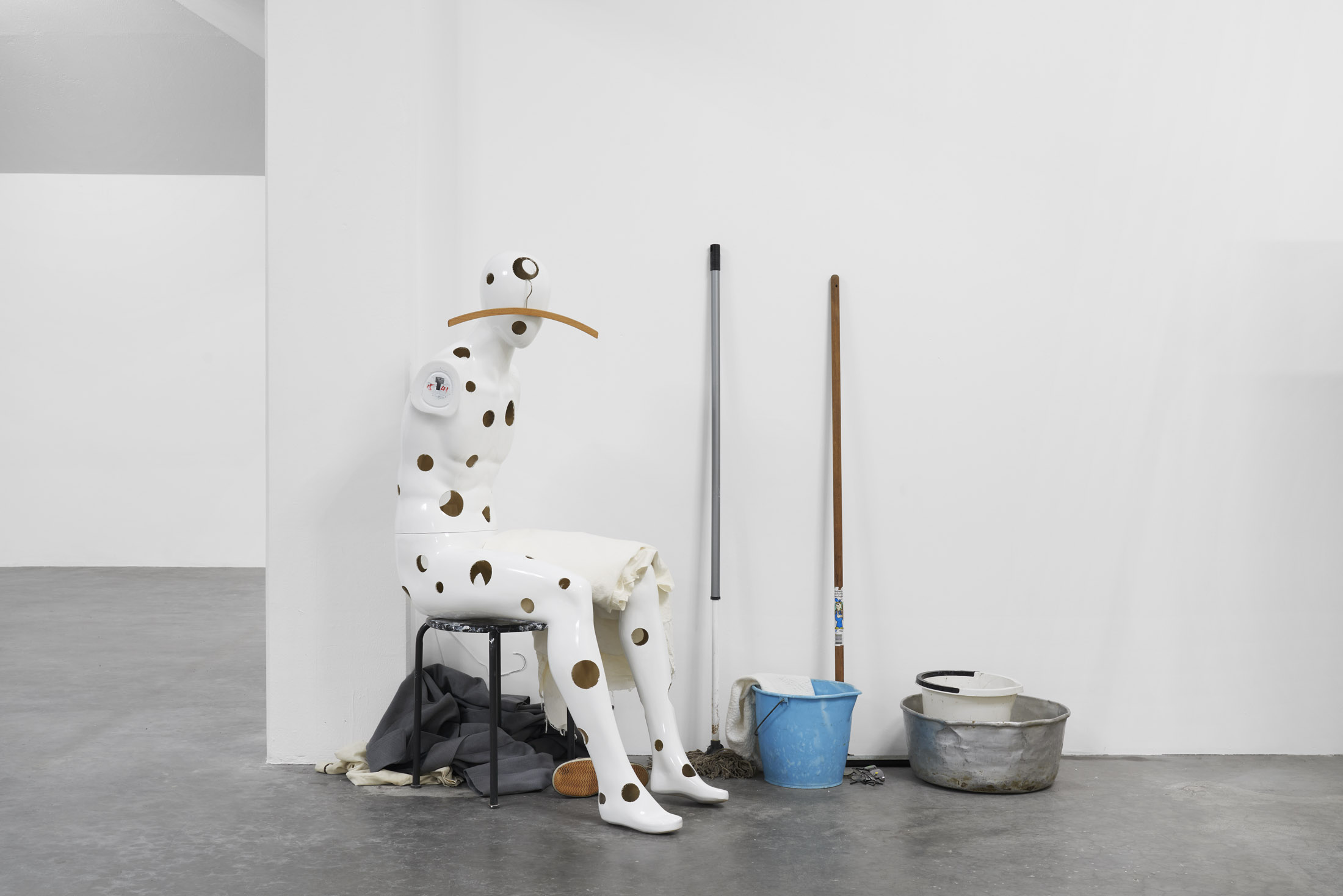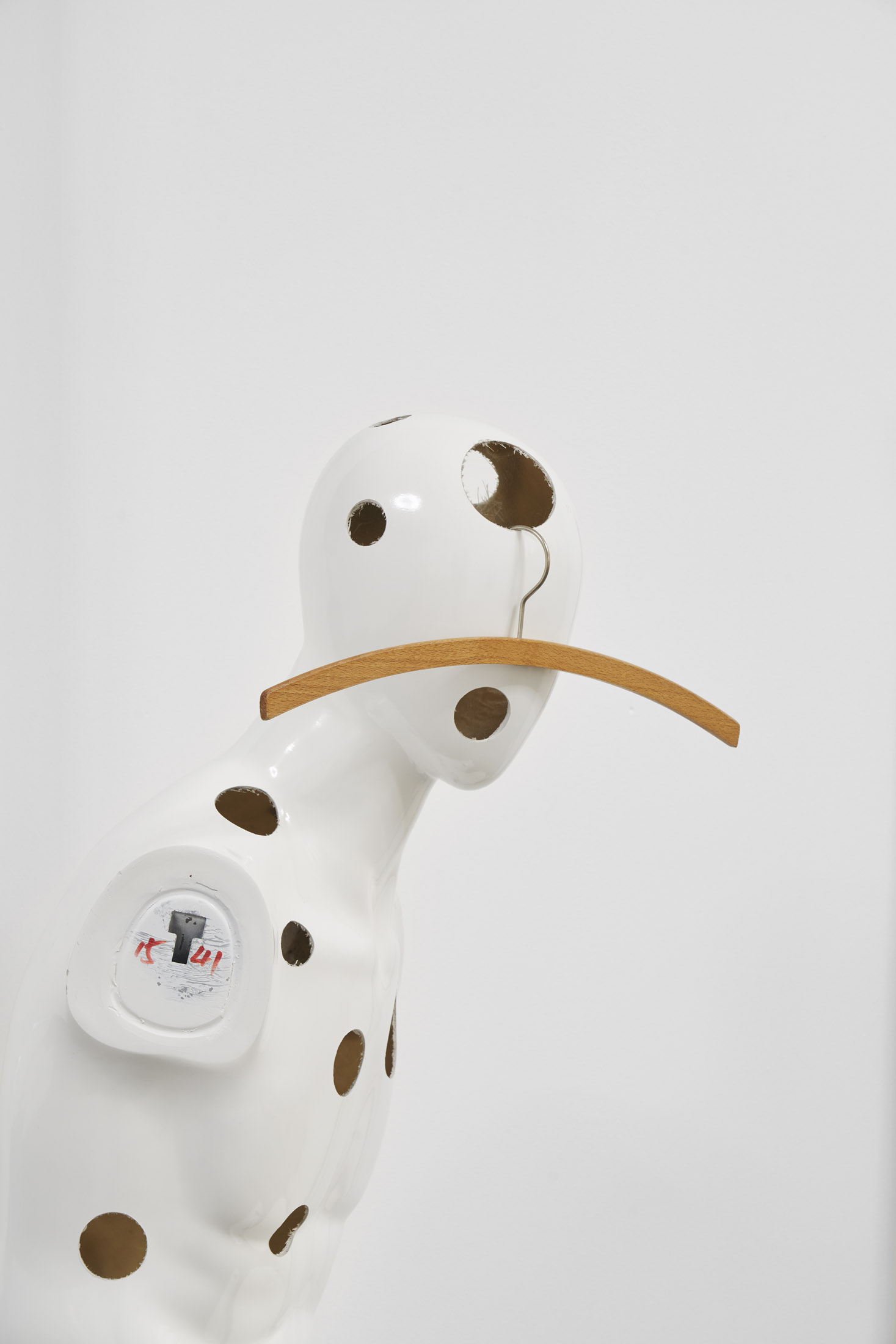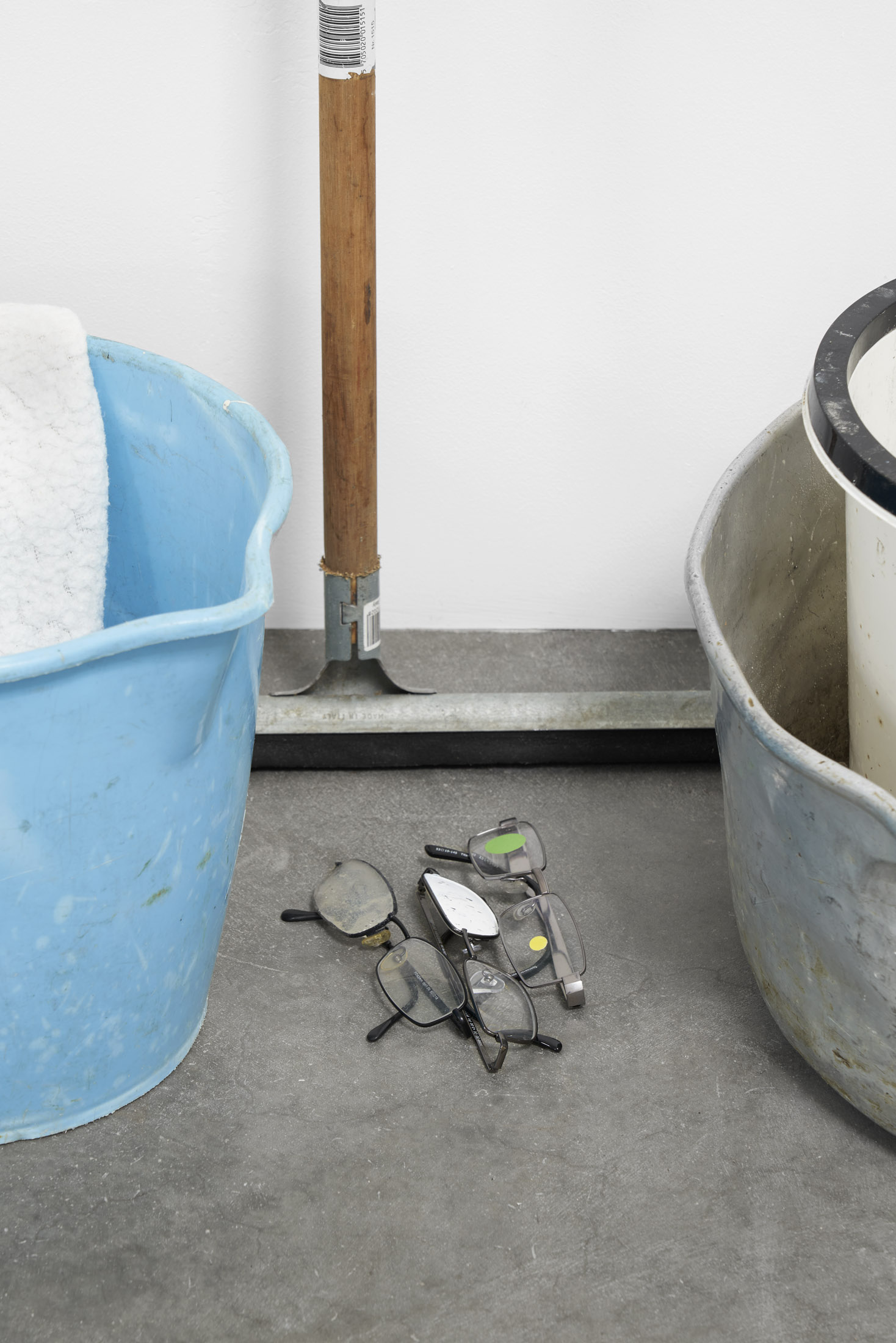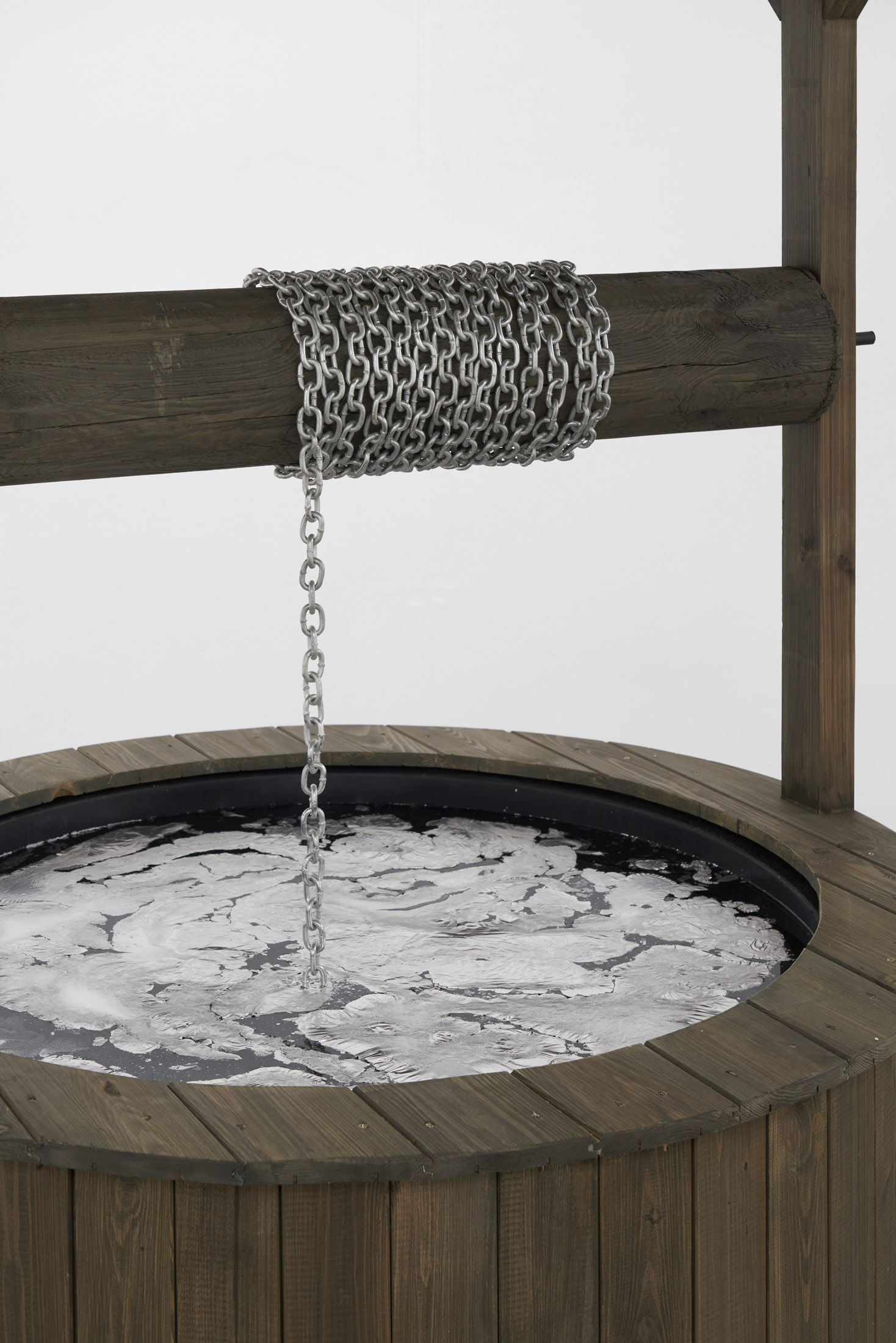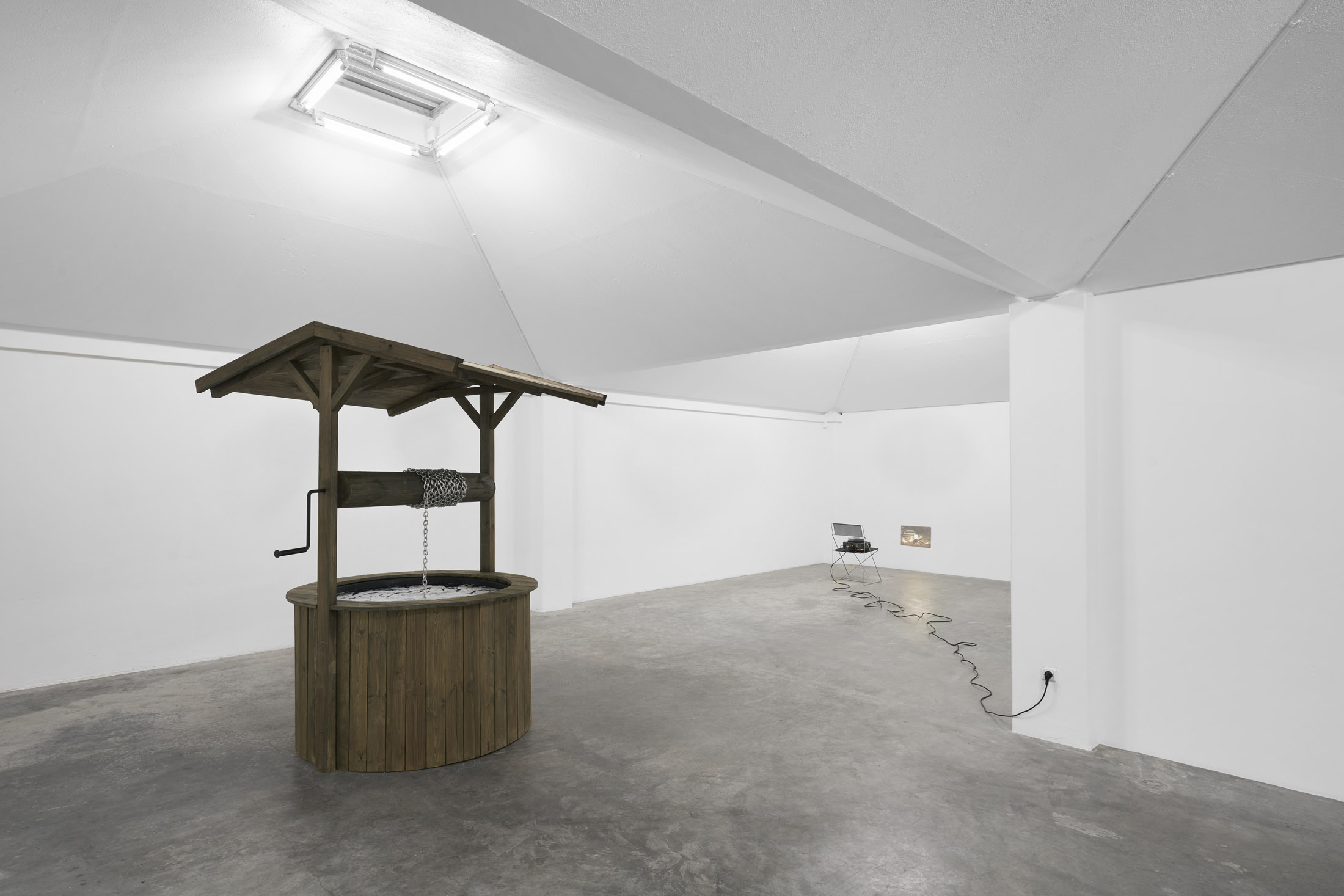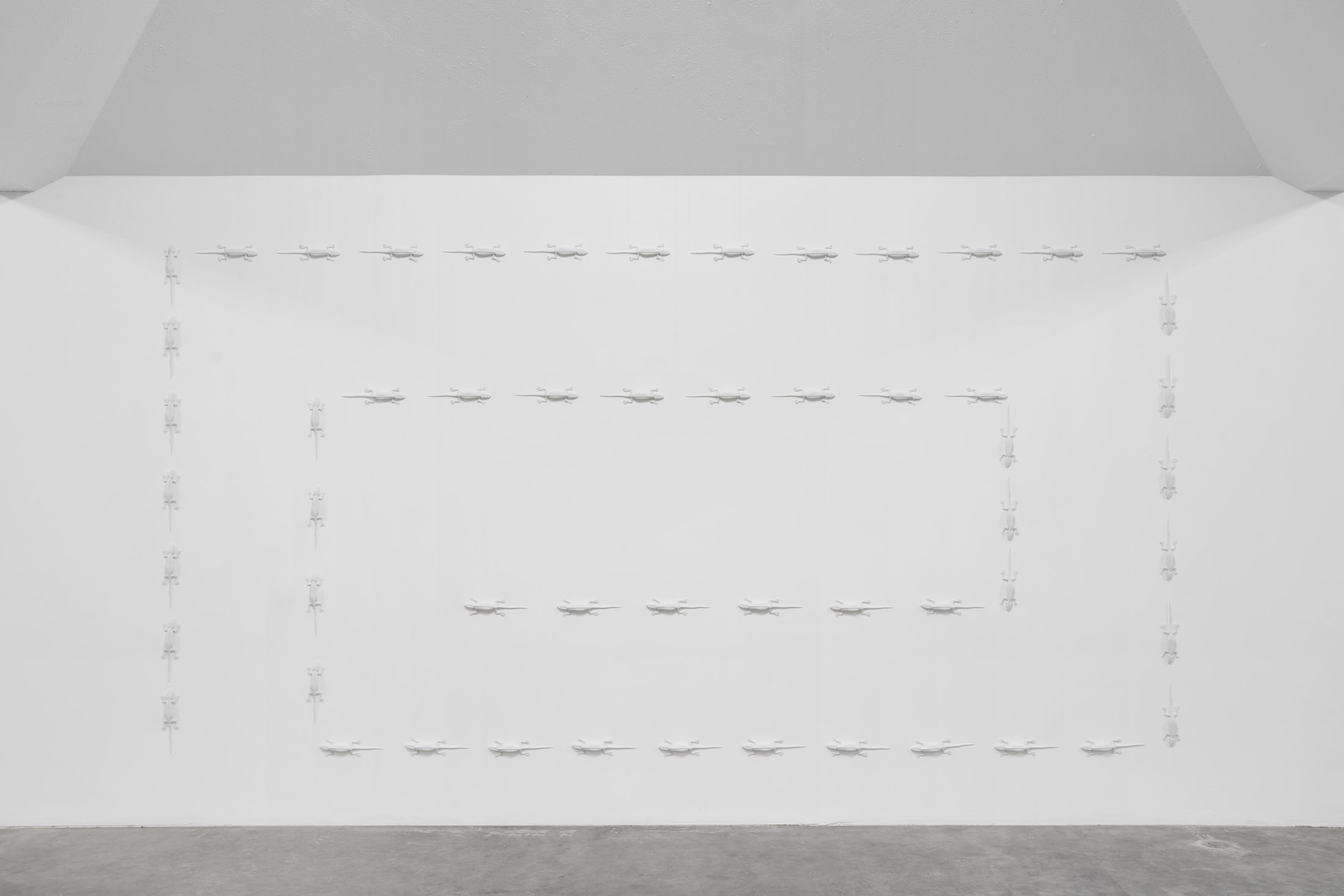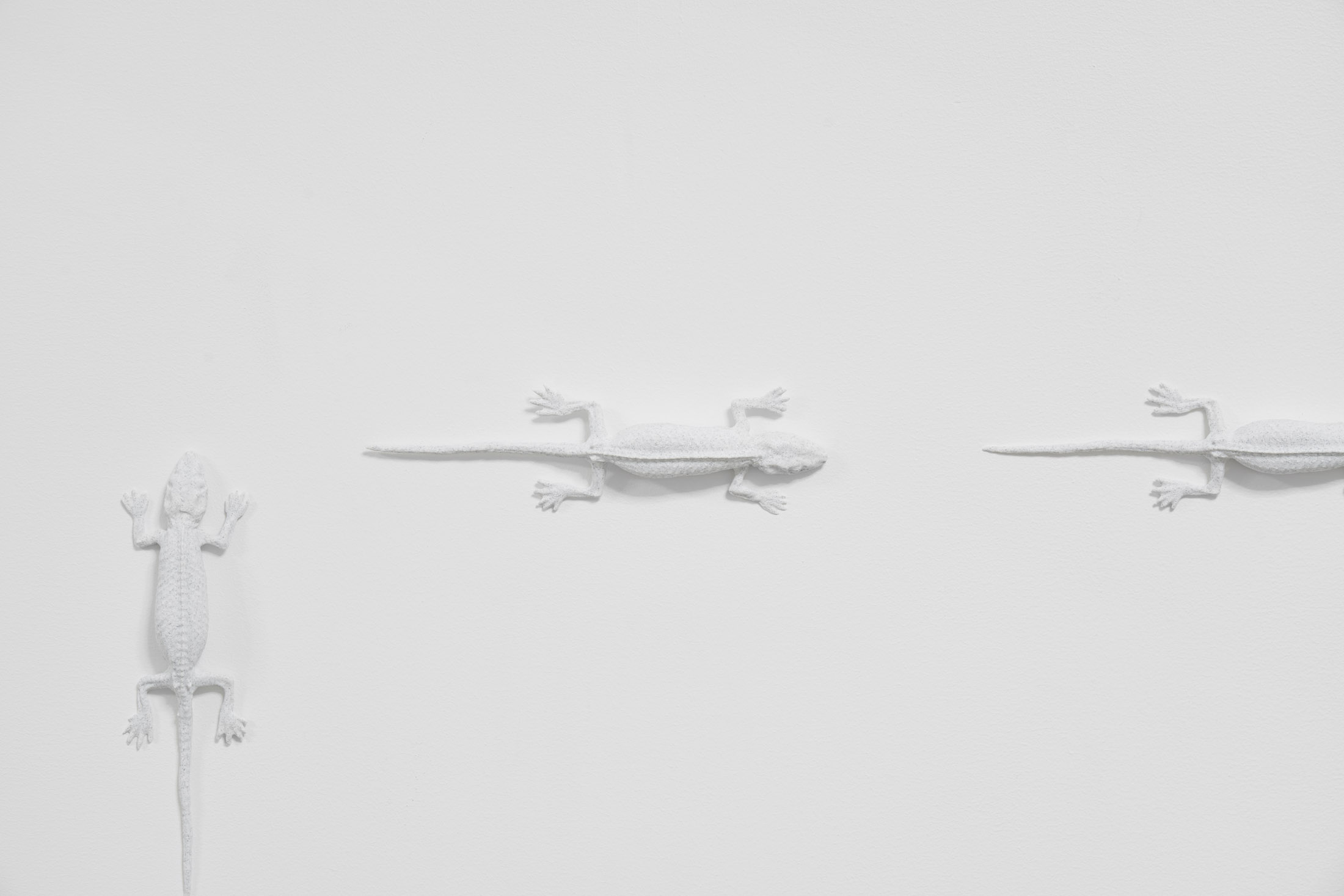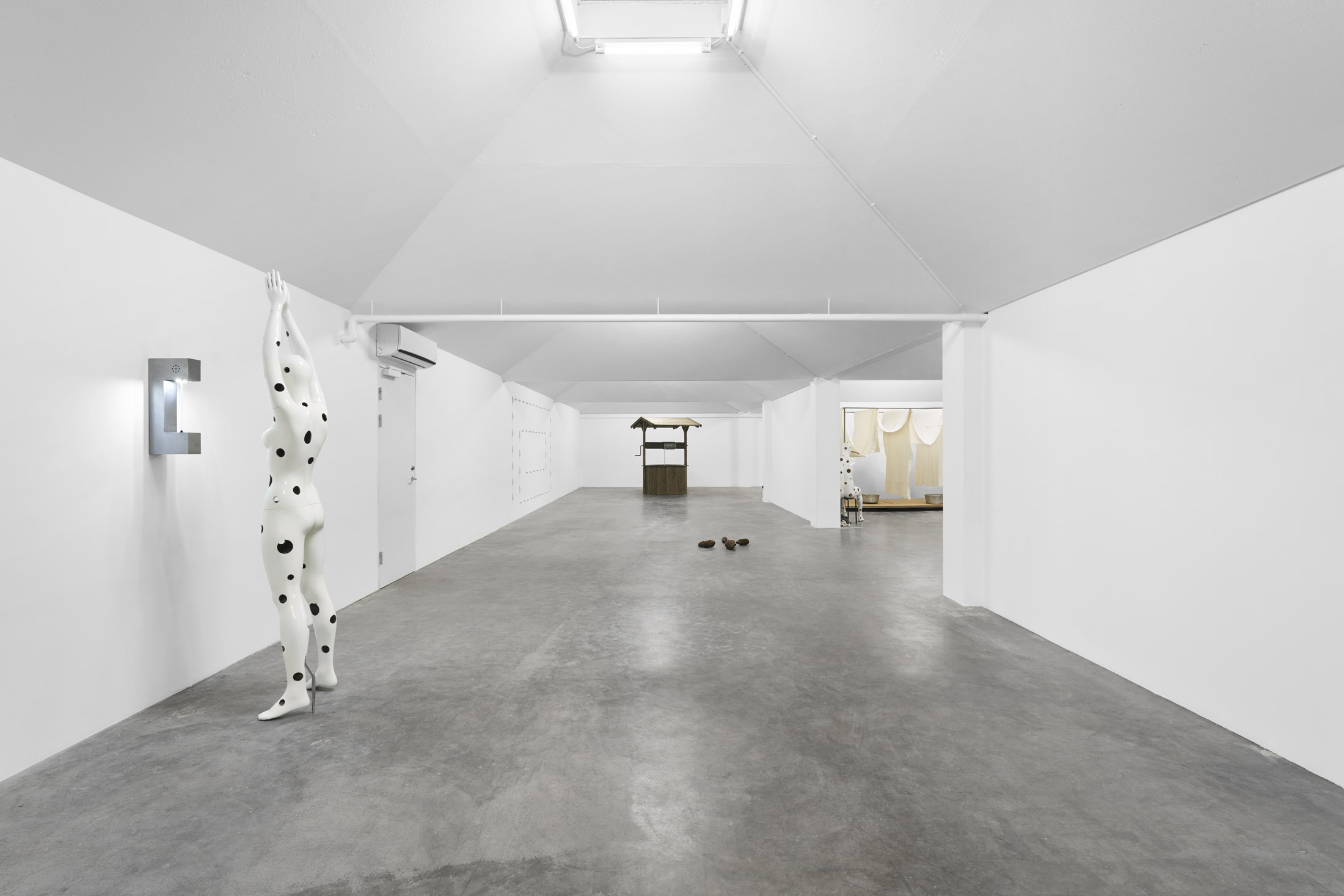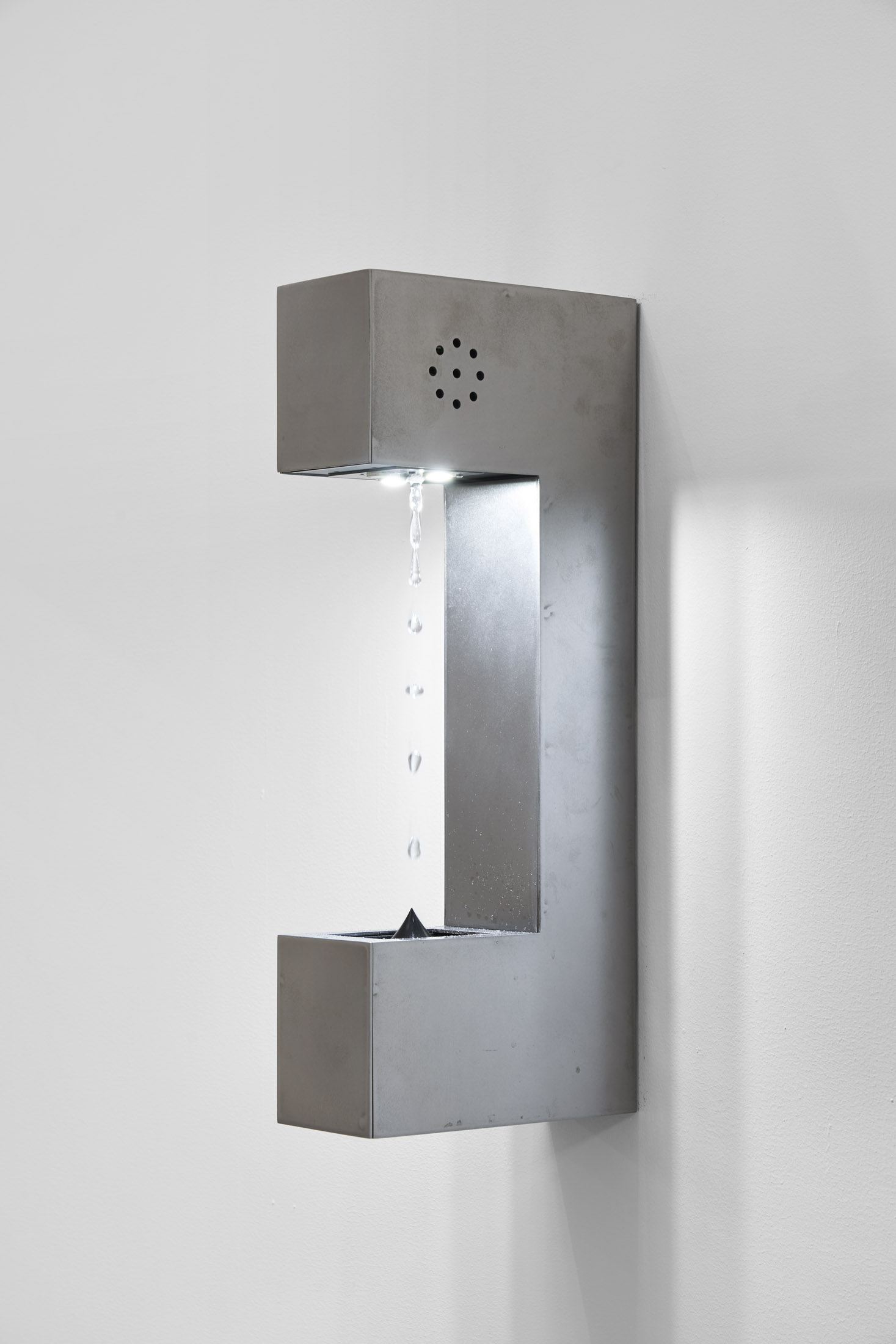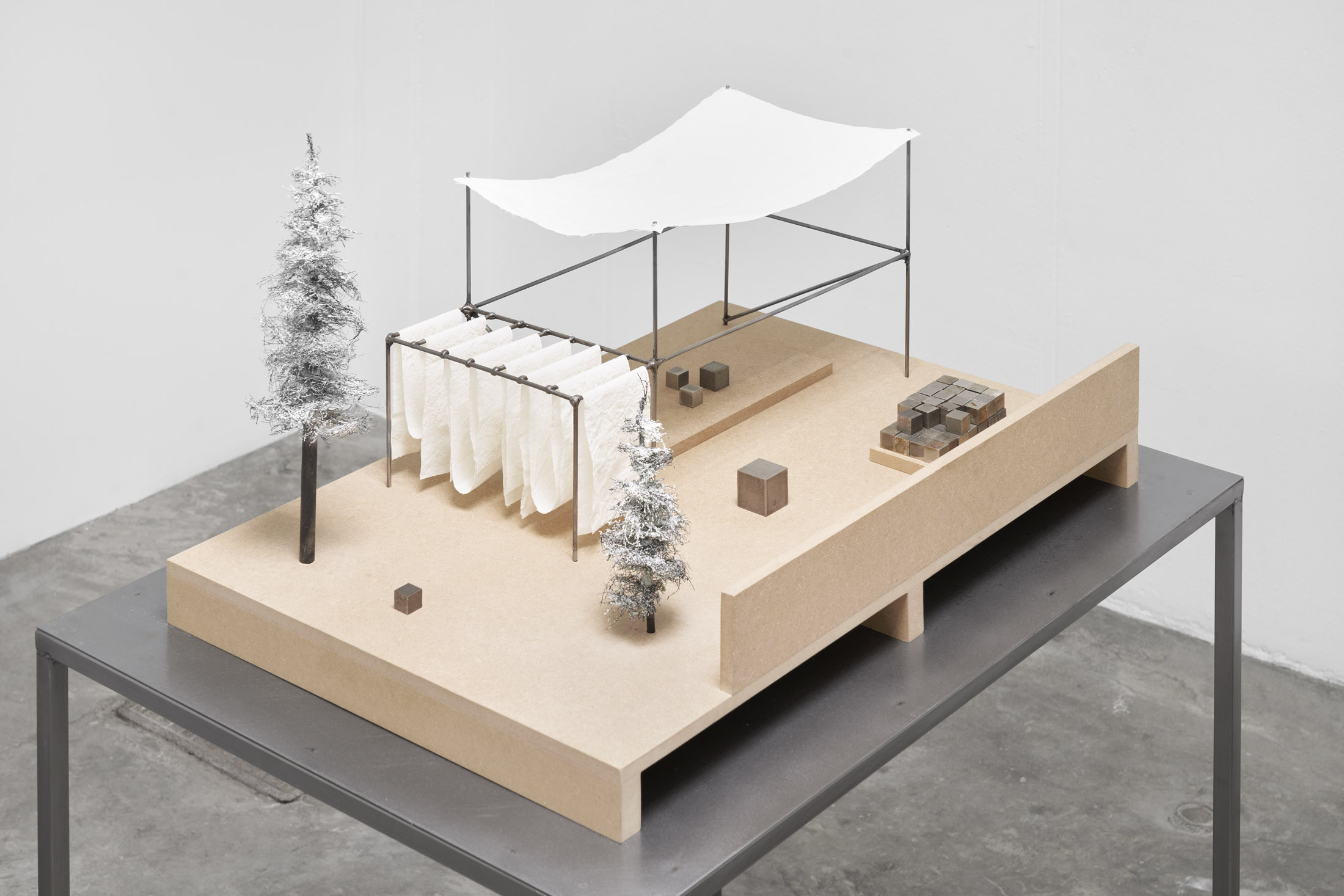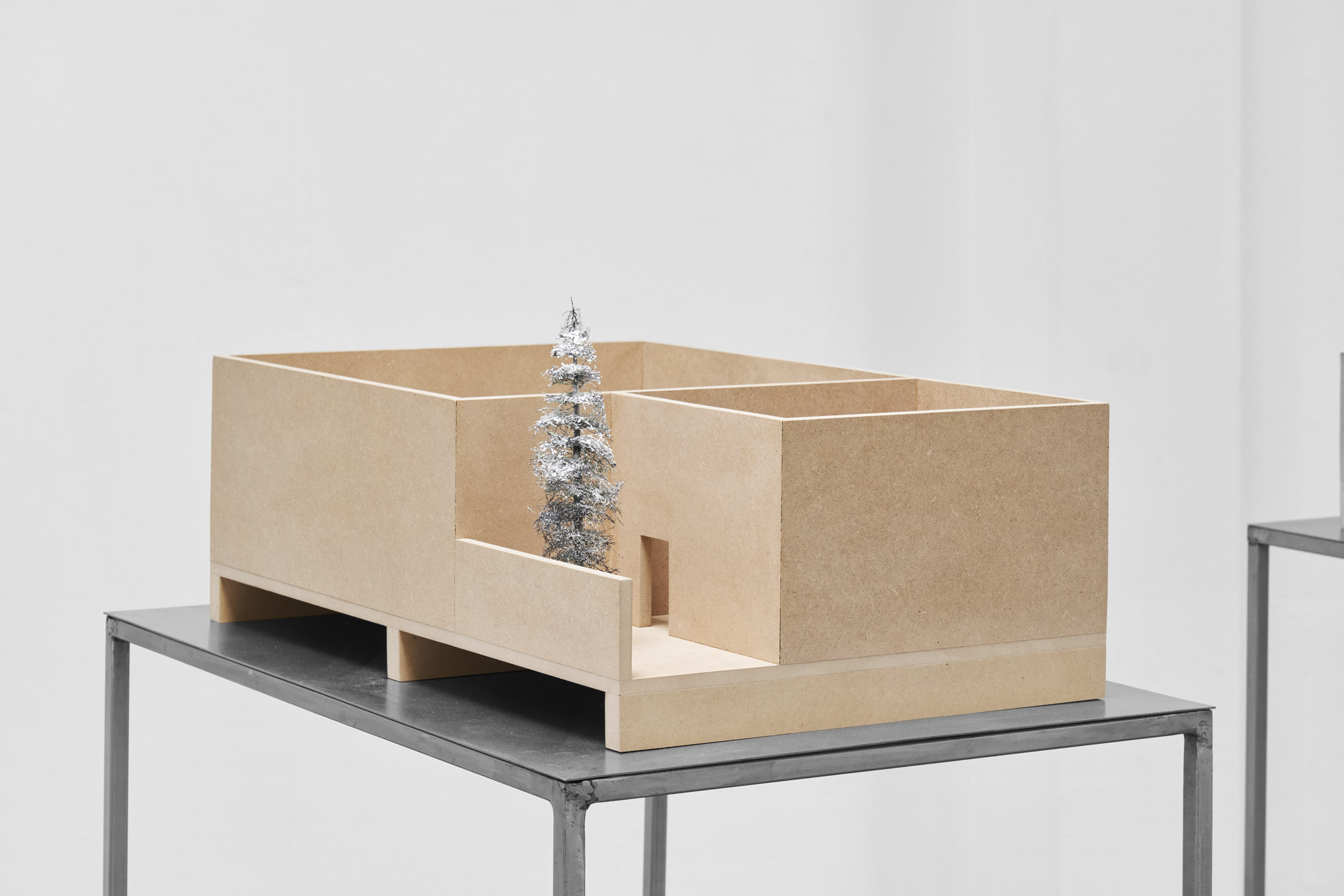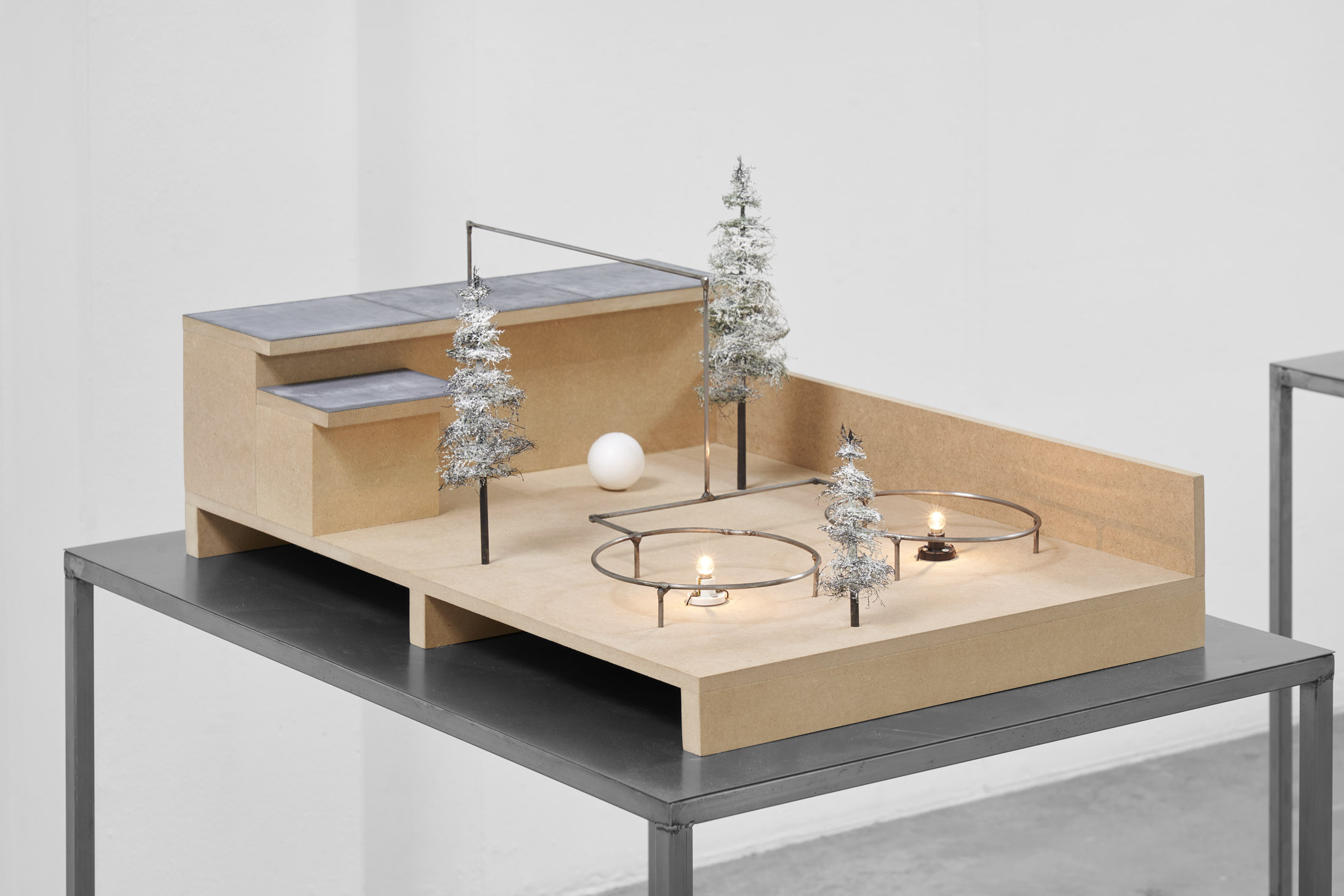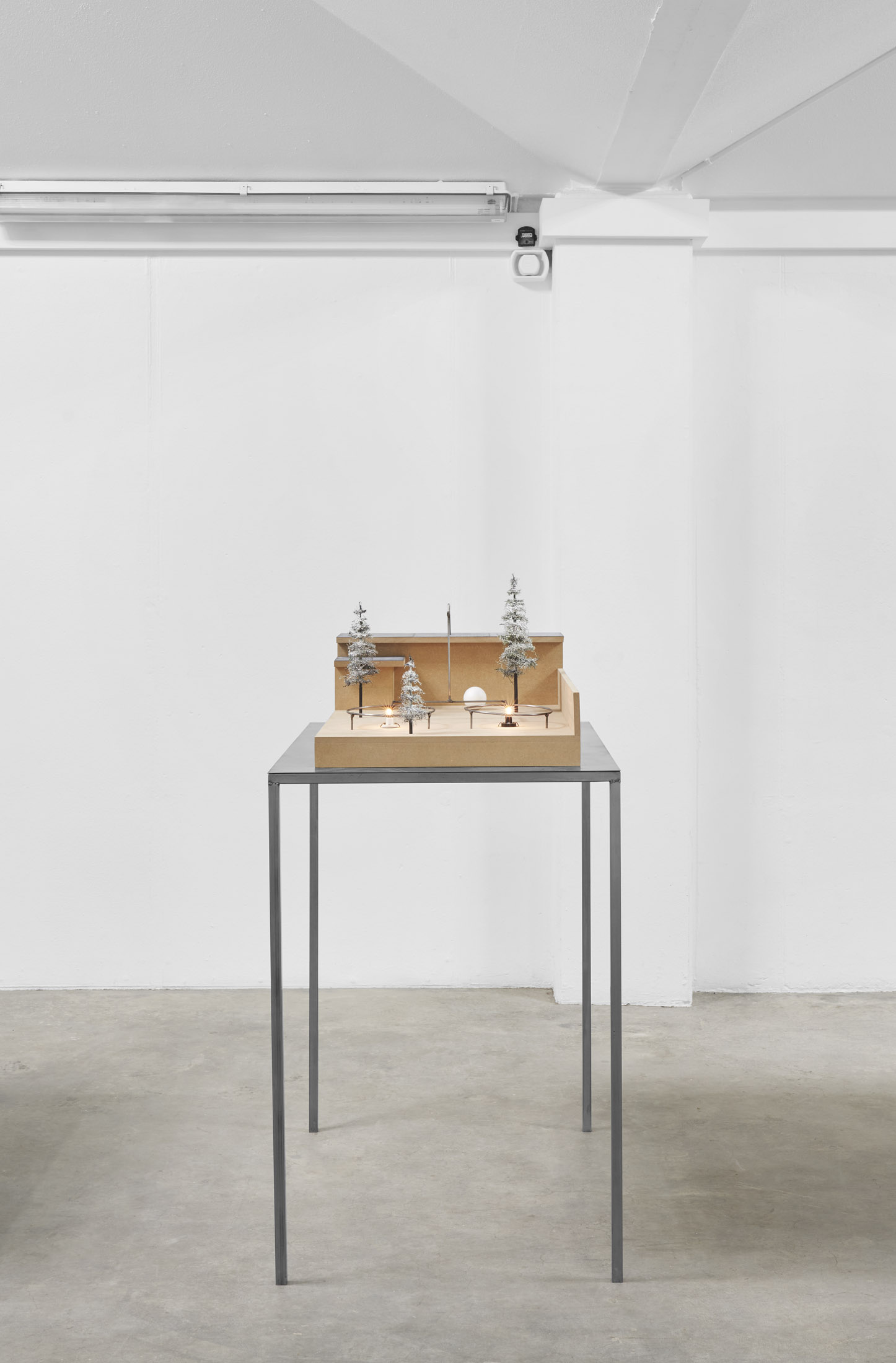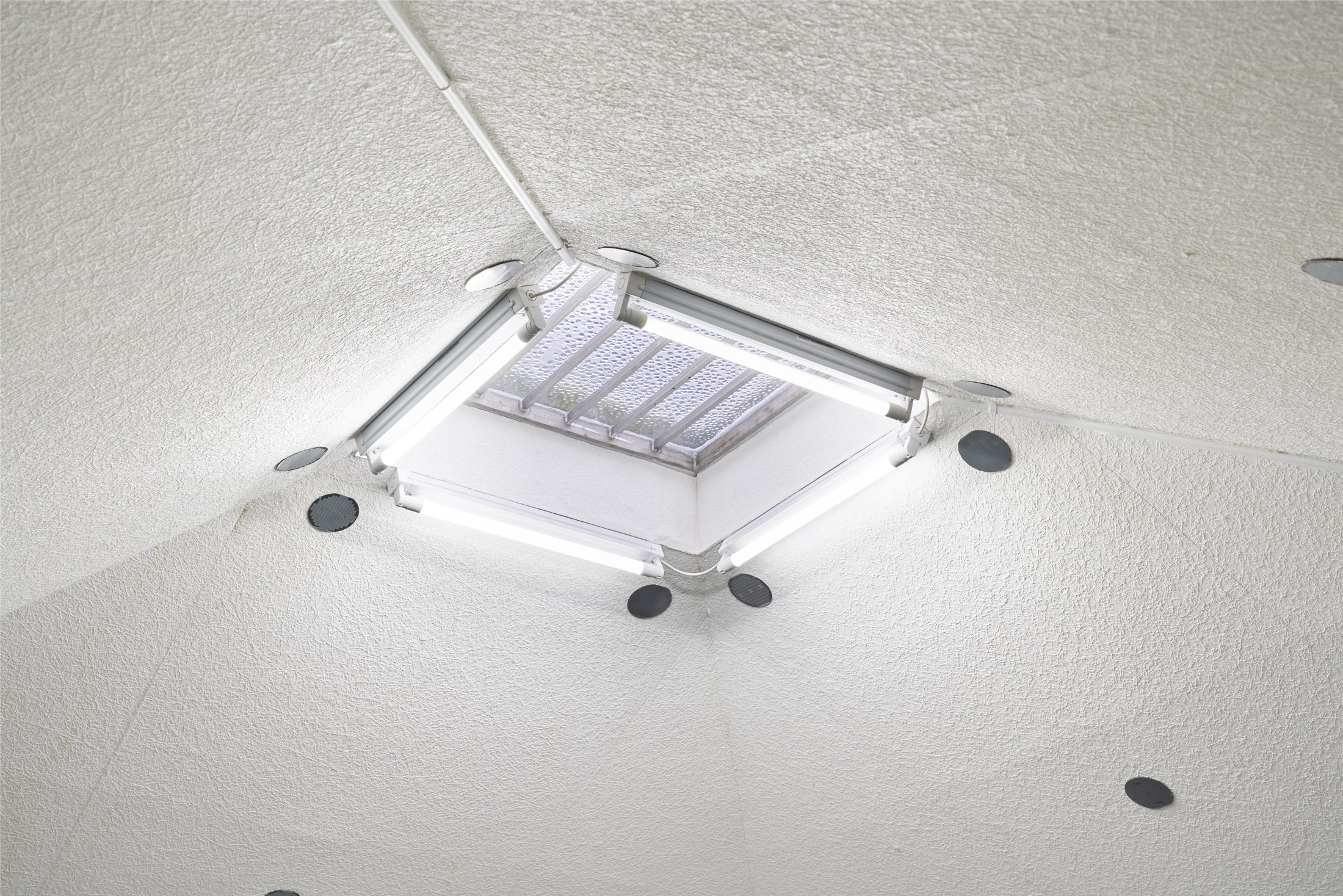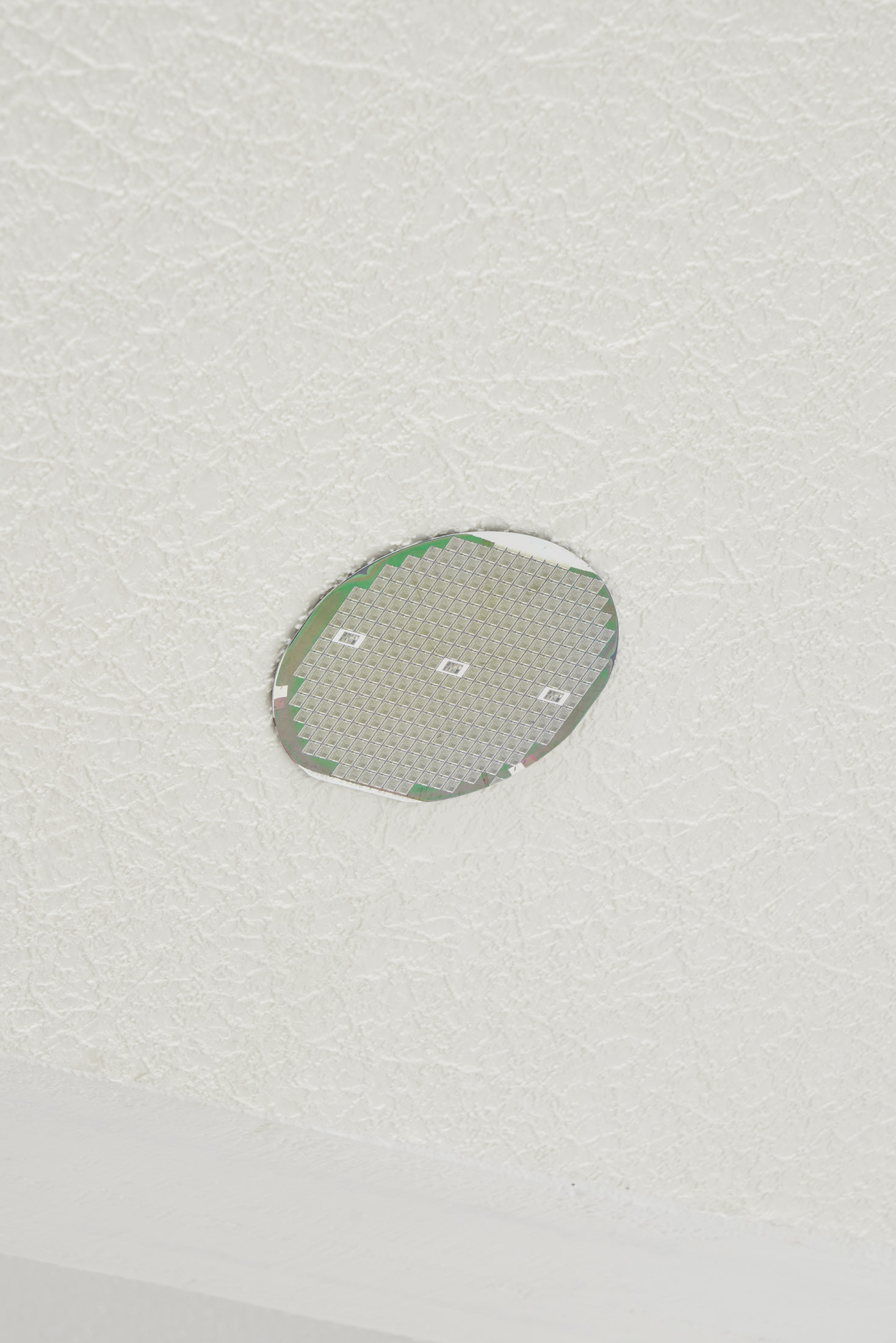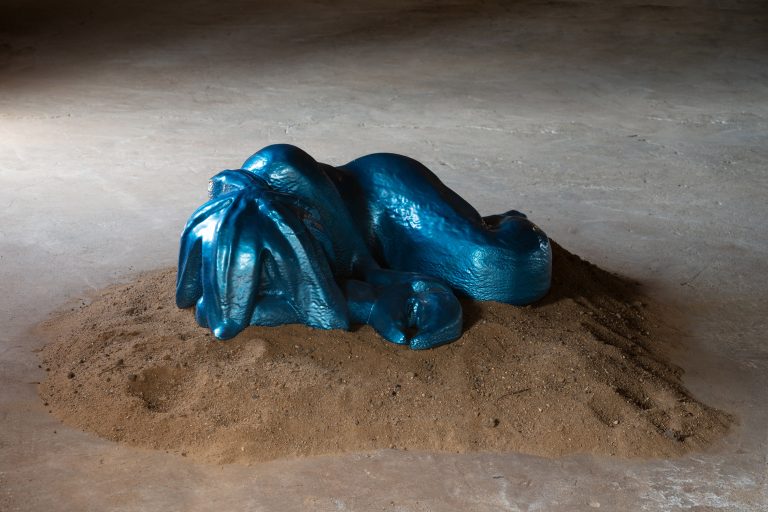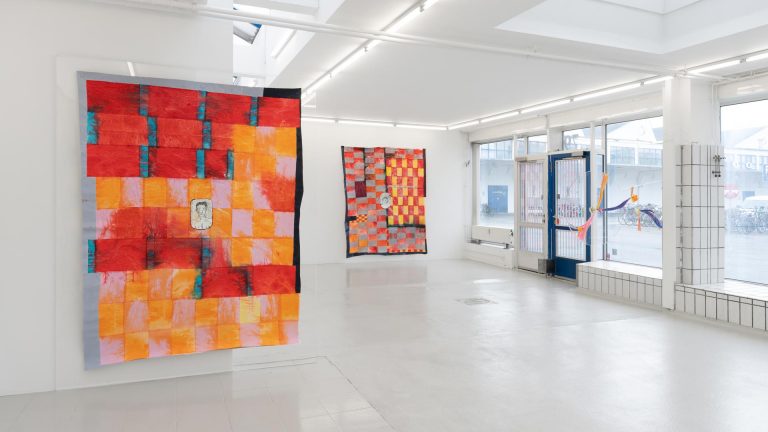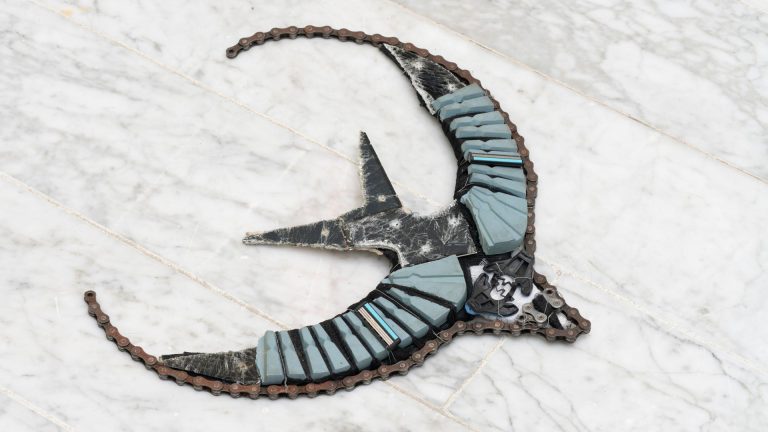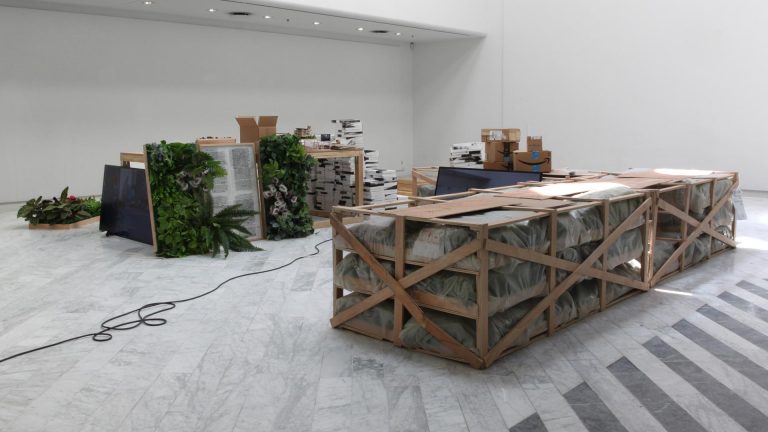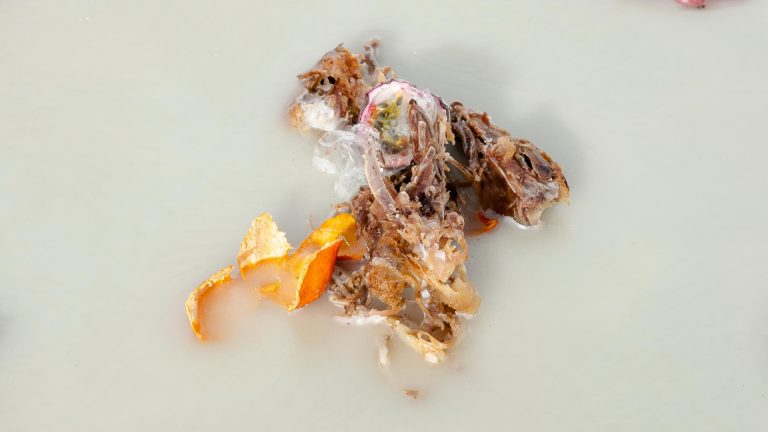Artists: Lukas Danys and Jan S. Hansen
Exhibition title: POV
Venue: Simian, Copenhagen, Denmark
Date: January 20 – March 31, 2024
Photography: GRAYSC / All images copyright and courtesy of the artist and Simian, Copenhagen
Note: Exhibition’s booklet is available here
Somehow there is a fundamental gap between the sensory perceptions of material surroundings and their translation into mental experiences. POV reflects on this surplus between the weight of our brains and our consciousness, known as The Hard Problem. Our maps have reached the fringes of the micro and the macro, yet somehow the mind and its lineaments remain an undisclosed frontier. From material, philosophical, and abstract perspectives, POV examines why, despite our growing understanding of world functions and mechanisms, we still can’t fully account for the presence, or even absence, of consciousness, intelligence, and experience. The exhibition proceeds with a commitment to the complexity and multilevel nature of the problem, and in particular an acknowledgement that, in order to map out the questions of intelligence and consciousness in all of its aspects and its multiple scales, one has to assemble and articulate different modes of knowledge.
As the title suggests, POV is concerned with the contingency of how one apprehends their environment, and how this interaction generates habits and models of the world at large. This inquiry is part of a long critique of perspectival representation, where the subject dissociates themselves from perceived objects, and orients their environment with themselves, the human, at the centre. Yet it is not simply a question of subjectivity and personalized experience, at best a partial perception of material reality, a limited viewpoint, or how these projections onto the environment are selective and altered representations of the world that can have pernicious effects. Rather the exhibition explores how shifts in perception, cognition, and consciousness yield fundamental changes in the subject, impacting how we think, communicate, and understand reality.
The exhibition choreographs a set of unstable viewpoints and representative paradigms to explore not only histories of cognitive estrangement and transcendence that break through social and phenomenological barriers, from mystical traditions to psychedelia to meditation to psychosocial therapies etc., but also to reveal how these practices and ways of knowing are rooted in specific technologies and techniques. The focus is not on concepts, but on percepts. The suggestion here is that rapid changes in our information environment provide new orientations, which must be attended to, and that such shifts may offer a possibility for the affirmation of a renewed planetary and collective consciousness. This notion is as visionary as it is practical and political.
Anecdotally, astronauts have reported that by leaving our atmosphere and looking back on Earth, they’ve experienced what has been called The Overview Effect, a sense of overwhelming awe and profound emotion triggered by the perceptual and conceptual vastness of infinite space and a sense of veneration for Earth as a complete and unified whole. The transformative experience of this perspectival shift was not unlike transcendental feelings in religious and spiritual traditions. The recent capture of the first-ever image of a black hole, stands in stark and perfect contrast to the now famed and faded belief in the image of our globe, seen from that outside vantage point.
POV proceeds from the understanding that changes in our self -conception necessarily lead to the transformation of our collective modes of acting. It is a program for artificialization, a scheme dedicated to exploring an outside or distanced view of ourselves. The exhibition is a complex diorama with a villa-like scenography that continuously confuses determinations of inside and outside. Drawing on cultural, psychological, and phenomenological tropes of the interior and exterior and private and public space, the works appear in an entangled manner, dislocating time and space and our embodied positions within this field. Allusions to the domestic environment and its interchange with the “outdoors” places us in our element, the human domain. But this comfort is continuously interrupted not only by the manifest artificiality of the constructions, but also through conflicting experiences of place and distance, where imminent experience contains a kernel of the infinite, the cosmic in the mundane.
The home, our ‘world,’ enclosed yet open, is here nested within a larger world, the biosphere, our universe. There is a simultaneous sense of particularization and generalization, where the assemblages at hand are seen as both representations and as autonomous and present sensible structures.
One can understand the presentation as a testing of models, in terms of physical models and representations, as well as the cognitive and ideological models through which we frame our environment. Here, each artwork apparatus unpacks, reduces, aggregates, and materializes a system, exteriorizing and making palpable dynamics that otherwise would be too complex, lofty, mundane, or tripped out to comprehend. By testing ideas as material forms, they make the invisible visible, and situate the viewer as an active co-agent in the production of meaning by making one aware of one’s own capacities and limits of awareness. When we encounter a human mannequin perforated with holes, it functions as a surrogate, a stand-in for ourselves and our permeability, but it also stands as an autonomous, immediate, figure which we confront 1:1 as another body in space. Familiar objects and scenarios, like a well or an information board, call us to act in a certain way, yet they also elicit immaterial qualities within this material reality that completes this “point of view” by generating an atmosphere, a vibe, what phenomenologists and consciousness researchers call qualia.
More than mere blueprints or tools for publicizing, materializing, or simplifying knowledge, the model here is treated as a tool that mediates between the mind, hands, and eyes, mingling the activities of discovery and manipulation. Models displace thought from the individual human mind, they are a prosthetic device that transports information from one domain or subject to the next and generates information about larger systems through enclosed representations that are projected out into the world. They are a technique that allows for a perceptual shift, a move from one’s entrenched perspective to an outside position. At the same time, this exteriorization is an emblematic perceptual mode, particularly in the West, which imagines one can only know the world by abstractly distancing ourselves from it.
Contesting the supposed neutrality of our models, the exhibition uses modelling as a key technique to not only explore specific dynamics, histories, and concepts around perception, but also to make visible the abstraction and manipulation of the model itself, the various ways our maps re-orient our practices and picture of the world. In our time of intense ecopolitical crisis and increasing global computation, models and simulations have become central to our daily lives. They map, and more and more determine, where we are and where we are going. As the sociologist Donald MacKenzie has observed, models today are “an engine not a camera,” they do not simply represent, they are a performative driver shaping how we interact with our world and the ways in which this interaction takes place.
Indeed, it is through models, language, and images that we process our being-in- the-world. Our perceptions are abstractions of sensory information, produced to operatively interpret and modify reality, ordering it as an image. Thinking does not just happen in our heads, but moves imaginatively across the boundaries of brain, body, and world. Yet the problem remains: what is this excess between the mechanistic functioning of our bodies and what we can call phenomenal experience, consciousness? Spirituality, science, and philosophy have long endeavoured to solve this hard problem by proliferating models and frameworks that help us discern these interactions. Yet awareness of a system does not mean one fully comprehends it.
One recent attempt at modelling consciousness, Integrated Information Theory (IIT), proposed by the neuroscientist Giulio Tononi, derives a mathematical calculus to measure the presence of conscious experience. Instead of looking at physical and neurological systems and searching for its presence from the outside, the theory looks from the inside out by acknowledging that consciousness is a fundamental property possessed by any system that has certain causal properties and a certain degree of complexity and self-awareness. In doing so, it suggests the presence of consciousness in places one would least expect it, and have come to understand consciousness and intelligence as an emergent property that arises through the complex organization of information, matter. This model harmonizes with the premises of panpsychism, a view shared in numerous mystical and philosophical traditions, that the entire universe, across every scale from micro to macro, has a certain spirit and awareness that is dynamic and part of an interconnected whole.
The fundamental building blocks of our world have a sort of rudimentary experience, everything feels something about its world and its relations to others all the way down to the most minute manner, and more complex intelligences, like our brains, are built up from these basic modules of consciousness. Along with this is a critique of the bifurcations of subject and object, man and nature, mind and matter, self and other. It “re-enchants” the universe by merging physical and mental properties, a view that functions as a counterpoint to the detached “coldness” of scientism, and allows us to reconstruct our place within an interconnected and non-dualistic ecology, and to recognize a certain consciousness, a universal vital force, what Hindus call Prana, as intrinsic to us and everything around us.
Today, there is much anxiety about the emergence of artificial intelligence as a threat to the exceptionalism of the human, and one of the main arguments goes that machines can never be conscious, only functioning as artificial imitations of human values. Yet, as POV suggests, isn’t it through models and artifices that we interact and construct our worlds? We have modelled our global computational systems after ourselves, and now that these formalisms are beginning to generate their own autonomy, they’ve started looking back at us and modelling us in turn. The optimists have noted that the dynamic and widely distributed exchanges of information in our increasingly computational environment may be revealing what was there all along, expanding our notions of what intelligence and consciousness is, even outside ourselves, in the words of the media theorist Friedrich Kittler, “Silicon is nature calculating itself”.
One could say that the proliferation of memes on the internet, for example, is a demonstration of novel forms of distributed consciousness which gives us a view on the role imitation, artificialization, and collective intelligence may play in our processes of meaning-making and world-building. Though there is an appropriate fear that potentially all our relations may be absorbed into a techno-capitalist dystopia where all intelligence is co-opted and controlled, isolating us from a universal consciousness, the changing coordinates of experience from digital media and mass computation are yet to be mapped, and are giving us new views on old hard problems.
Perhaps this is why psychedelic and esoteric cultures and practices have seen a revival in our age. As a response to times of crisis and change, such attempts to expand the mind and explore the limits of perception and consciousness are a means of smoothing cultural transitions and the shocks of new mediated experiences. The blurring of boundaries, feelings of universal connection, and hyper-associative points of view in the psychedelic or transcendental experience are like the cognitive and perceptual leaps endemic to the electric vortex that is our increasingly techno-biological environment. And through these forms of expanded and empathic perception, we are observing an evolution of cognitive acquisition and collective, distributed, consciousness, a certain “collective effervescence” which is opening the doors for new models and modes of being and perceiving to emerge.
Tapping into the omnipresence of ‘awareness’ in cultural discourse today, full of political, conspiratorial, and practical associations, POV is critically ambivalent to these technological and sociological changes, while at the same time, curious about how such transformations play a part in the continual conception and transformation of ourselves. Through scenographic constructions and the production of arcane gadgets and models, the exhibition maps the deficiencies of our technological, scientific, philosophical, and spiritual paradigms to account for consciousness and takes its own turn into a more fluid and abstract inner realm.
-Text by Post Brothers
Lukas Danys (1988, Kaunas), lives and works in Copenhagen. Education, selected: The Royal Danish Academy of Fine Arts, School of Visual Arts; Faculty of Fine Arts of the University of Lisbon. Exhibited work, selected: Obsession, Nida Art Colony, Lithuania; Archway Nightlands Connector Jennifer-See Alternate, Copenhagen, Denmark; Belas Artes, Lisbon, Portugal; West Germany, Berlin; Kreuzberg Pavillon, Berlin, Germany; Kabinetas, Kaunas, Lithuania. Residencies, selected: Nida Art Colony, AqTushetii residency. Grants/awards, selected: Grosserer L.F. Foghts Foundation, Sozziparken and Council of Visual Arts, Copenhagen Municipality. Curatorial work: Rewild, Copenhagen, Denmark; In Situ, Copenhagen, Denmark; Paranormal, Copenhagen, Denmark.
Jan S. Hansen (1980, Haderslev), lives and works in Copenhagen. He is one of the founders of Simian. Education, selected: The Royal Danish Academy of Fine Arts, School of Visual Arts; The European Graduate School, Division of Philosophy, Art and Critical Thought, Saas-Fee, Switzerland and Copenhagen University, Faculty of Humanities, Epistemology and Philosophy of Mind, Copenhagen, Denmark. Exhibited work, selected: O – Overgaden, Copenhagen, Denmark; Den Frie Centre of Contemporary Art, Copenhagen, Denmark; Kunsthal Charlottenborg, Copenhagen, Denmark; Kunsthal Nord, Aalborg, Denmark; Huset for Kunst og Design, Holstebro, Denmark; Hvidovre Main Library, Hvidovre, Denmark; CCA Andratx, Andratx, Spain and The Danish Institute in Rome, Rome, Italy. Curatorial work: Co-director, Simian, Copenhagen, Denmark; Co-director, IMO, Copenhagen, Denmark.
Lukas Danys and Jan S. Hansen, POV, 2024, exhibition view, Simian, Copenhagen
Lukas Danys, dependency I, 2024, Information board, salt, foam bean bag filler, food color
Jan S. Hansen, Untitled, 2024, Altered mannequin, cardboard box, glove, lamps, extension cords, bird feces, glue, resin, spray varnish
Jan S. Hansen, Untitled, 2024, Altered mannequin, cardboard box, glove, lamps, extension cords, bird feces, glue, resin, spray varnish
Jan S. Hansen, Untitled, 2024, Altered mannequin, cardboard box, glove, lamps, extension cords, bird feces, glue, resin, spray varnish
Lukas Danys and Jan S. Hansen, POV, 2024, exhibition view, Simian, Copenhagen
Lukas Danys and Jan S. Hansen, POV, 2024, exhibition view, Simian, Copenhagen
Jan S. Hansen, Untitled, 2024, Laser cut jacket, hanger, sticker
Jan S. Hansen, Union, 2024, Door, multi-user lock system, padlocks, window
Jan S. Hansen, Union, 2024, Door, multi-user lock system, padlocks, window
Lukas Danys and Jan S. Hansen, POV, 2024, exhibition view, Simian, Copenhagen
Lukas Danys and Jan S. Hansen, POV, 2024, exhibition view, Simian, Copenhagen
Lukas Danys, dependency II, 2024, Information board, salt, foam bean bag filler, food color
Lukas Danys, dependency II, 2024, Information board, salt, foam bean bag filler, food color
Lukas Danys, WAIT STATION, 2024, Multiwall, flatbed print, plastic chair mats
Lukas Danys, WAIT STATION, 2024, Multiwall, flatbed print, plastic chair mats
Lukas Danys and Jan S. Hansen, POV, 2024, exhibition view, Simian, Copenhagen
Lukas Danys and Jan S. Hansen, POV, 2024, exhibition view, Simian, Copenhagen
Jan S. Hansen, Scotoma, 2023, Graph paper, laser print, paper, pencil, permanent marker, ballpoint pen, stickers, tape, aluminum frame
Jan S. Hansen, Scotoma, 2023, Graph paper, paper, stickers, dust, tape, aluminum frame
Jan S. Hansen, Scotoma, 2023, Laser print, paper, ballpoint pen, ink, stickers, tape, aluminum frame
Jan S. Hansen, Scotoma, 2023, Graph paper, laser print, pencil, permanent marker, ballpoint pen, stickers, tape, aluminum frame
Jan S. Hansen, Scotoma, 2023, Laser print, paper, ballpoint pen, ink, stickers, tape, aluminum frame
Jan S. Hansen, Helix, 2024, Steel, soldered blank keys
Jan S. Hansen, Helix, 2024, Steel, soldered blank keys
Lukas Danys and Jan S. Hansen, POV, 2024, exhibition view, Simian, Copenhagen
Lukas Danys, Operation manual, 2024, Stage table, lamp, breathing spheres, spray paint
Lukas Danys, Operation manual, 2024, Stage table, lamp, breathing spheres, spray paint
Lukas Danys, how2find, 2024, Video loop, 11 seconds, 3D animation by Miglė Vyčinaitė
Lukas Danys, Resulting structures, 2024, Banksia cones
Lukas Danys, Resulting structures, 2024, Banksia cones
Lukas Danys, Resulting structures, 2024, Banksia cones
Lukas Danys and Jan S. Hansen, POV, 2024, exhibition view, Simian, Copenhagen
Jan S. Hansen, Kosha, 2024, Altered mannequin, chair, steel, MDF, cotton, water, aluminum basins, buckets, glasses with stickers/silicone/white out marker, clothes, hangers, rubber boot, floor squeegees, mop, ladder
Jan S. Hansen, Kosha, 2024, Altered mannequin, chair, steel, MDF, cotton, water, aluminum basins, buckets, glasses with stickers/silicone/white out marker, clothes, hangers, rubber boot, floor squeegees, mop, ladder
Jan S. Hansen, Kosha, 2024, Altered mannequin, chair, steel, MDF, cotton, water, aluminum basins, buckets, glasses with stickers/silicone/white out marker, clothes, hangers, rubber boot, floor squeegees, mop, ladder
Jan S. Hansen, Kosha, 2024, Altered mannequin, chair, steel, MDF, cotton, water, aluminum basins, buckets, glasses with stickers/silicone/white out marker, clothes, hangers, rubber boot, floor squeegees, mop, ladder
Jan S. Hansen, Kosha, 2024, Altered mannequin, chair, steel, MDF, cotton, water, aluminum basins, buckets, glasses with stickers/silicone/white out marker, clothes, hangers, rubber boot, floor squeegees, mop, ladder
Lukas Danys and Jan S. Hansen, POV, 2024, exhibition view, Simian, Copenhagen
Lukas Danys, Harmony reduction, 2024, Stained wood, plastic bucket, chain, water, chrome paint
Lukas Danys, Harmony reduction, 2024, Stained wood, plastic bucket, chain, water, chrome paint
Lukas Danys, Harmony reduction, 2024, Stained wood, plastic bucket, chain, water, chrome paint
Lukas Danys and Jan S. Hansen, POV, 2024, exhibition view, Simian, Copenhagen
Jan S. Hansen, Tetra lll, 2024, Steel, projector, 81 laser cut slides, chair
Jan S. Hansen, Tetra lll, 2024, Steel, projector, 81 laser cut slides, chair
Jan S. Hansen, Tetra lll, 2024, Steel, projector, 81 laser cut slides, chair
Jan S. Hansen, Untitled, 2024, PLA 3D print, magnet
Jan S. Hansen, Untitled, 2024, PLA 3D print, magnet
Lukas Danys and Jan S. Hansen, POV, 2024, exhibition view, Simian, Copenhagen
Jan S. Hansen, Fascination, 2024, Altered mannequin, strobe light water fountain, steel, water, pitched down Nesting Cranes from Golden Record on Voyager 1+2, speaker, iPod
Jan S. Hansen, Fascination, 2024, Altered mannequin, strobe light water fountain, steel, water, pitched down Nesting Cranes from Golden Record on Voyager 1+2, speaker, iPod
Lukas Danys and Jan S. Hansen, POV, 2024, exhibition view, Simian, Copenhagen
Lukas Danys and Jan S. Hansen, POV, 2024, exhibition view, Simian, Copenhagen
Jan S. Hansen, Intermodular Habitat, 2024, Steel, MDF, corrugated lead sheets, cotton, scale model trees
Jan S. Hansen, Intermodular Habitat, 2024, Steel, MDF, corrugated lead sheets, stainless steel bowls, water, laser cut spoon, scale model trees
Jan S. Hansen, Intermodular Habitat, 2024, Steel, MDF, corrugated lead sheets, stainless steel bowls, water, laser cut spoon, scale model trees
Jan S. Hansen, Intermodular Habitat, 2024, Steel, MDF, corrugated lead sheets, polystyrene ball, light sockets, bulbs, electronics, power bank, scale model trees
Jan S. Hansen, Intermodular Habitat, 2024, Steel, MDF, corrugated lead sheets, polystyrene ball, light sockets, bulbs, electronics, power bank, scale model trees
Jan S. Hansen, Intermodular Habitat, 2024, Steel, MDF, corrugated lead sheets, cotton, scale model car, scale model trees
Lukas Danys, The sun is hitting the wall sideways, 2024, Wallpaper, silicon wafers
Lukas Danys, The sun is hitting the wall sideways, 2024, Wallpaper, silicon wafers
Lukas Danys, The sun is hitting the wall sideways, 2024, Wallpaper, silicon wafers


